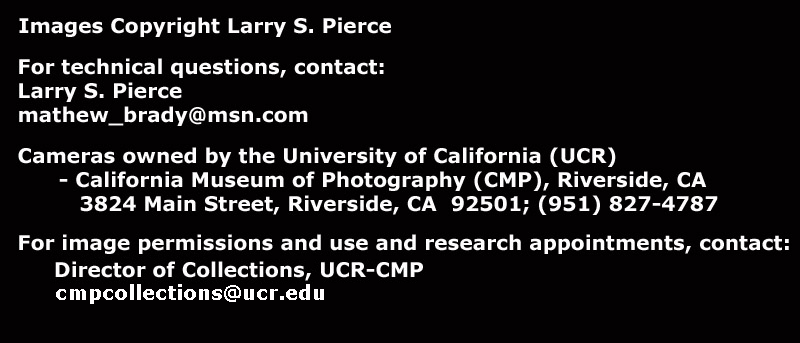American Optical Company, Scovill Mfg. Co.
The 76 Camera Variation 2.0 (Catalog Version)
The Pocket Camera
(~1875-~1882)
76 Camera
(refers only to size #203)(1876-~1896)
American Optical Co.'s Apparatus Outfits
(#201-204)(~1882-1886)
Centennial
Outfits (#201-204)(1887-~1896)
Dry Plate Making for Amateurs, Scovill &
American Optical Catalog, 1886, p. 35
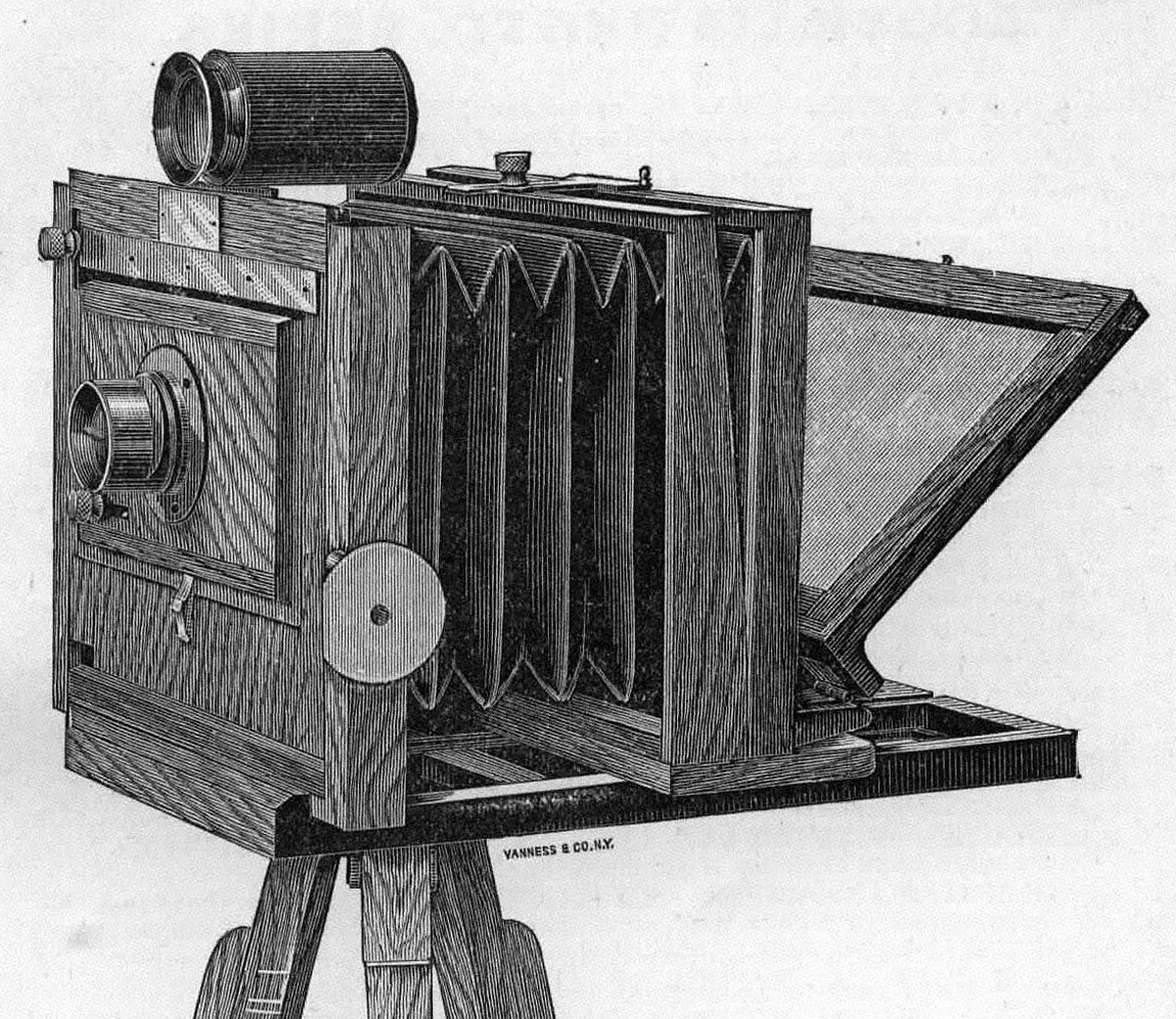
Dry
Plate Making for Amateurs, Scovill & American Optical Catalog, 1886, p.
19
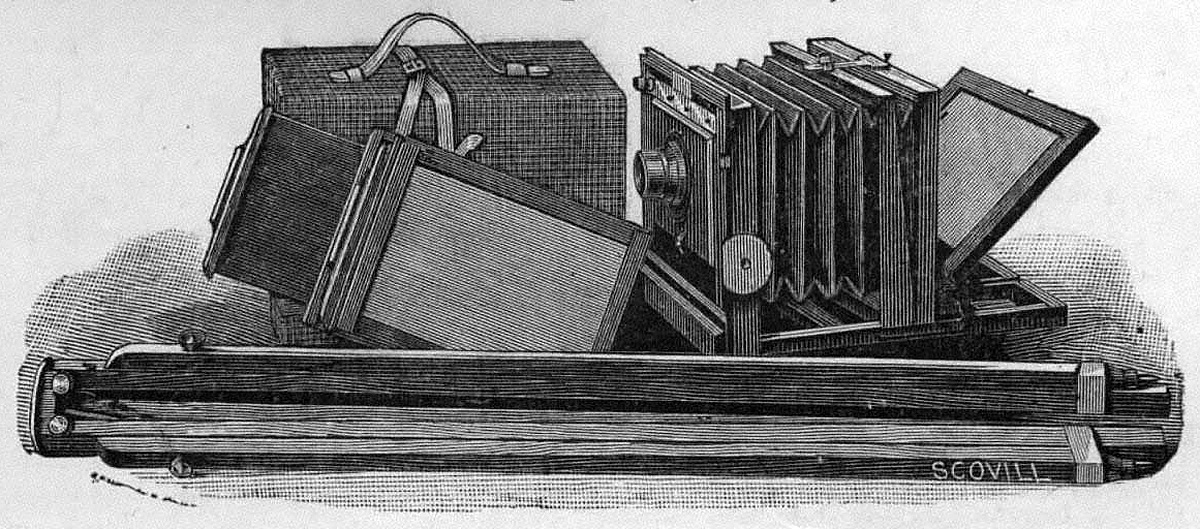
American Optical Apparatus Outfit Camera
No. 202 (4 x 5), also known as The 76 Camera.
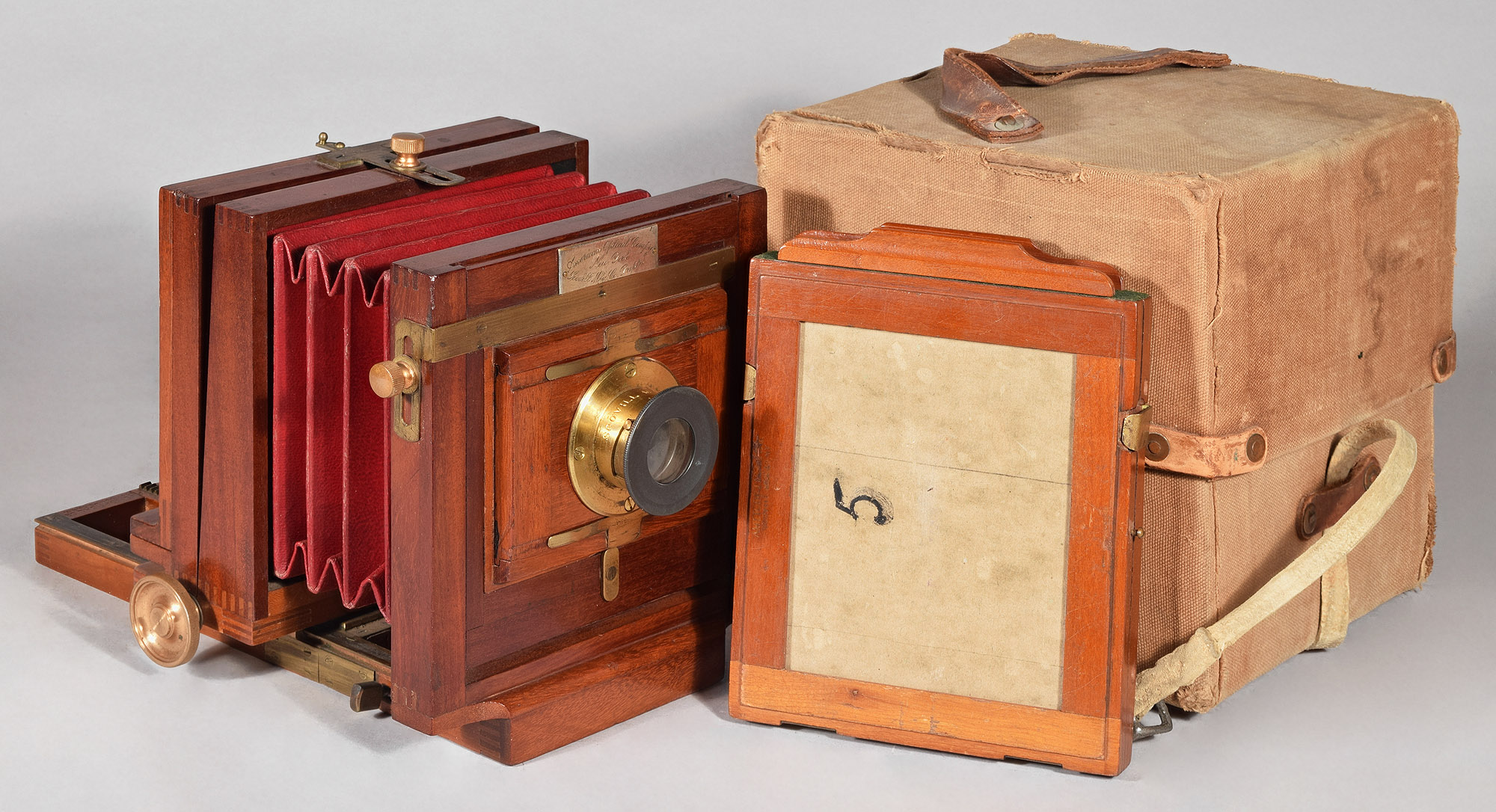
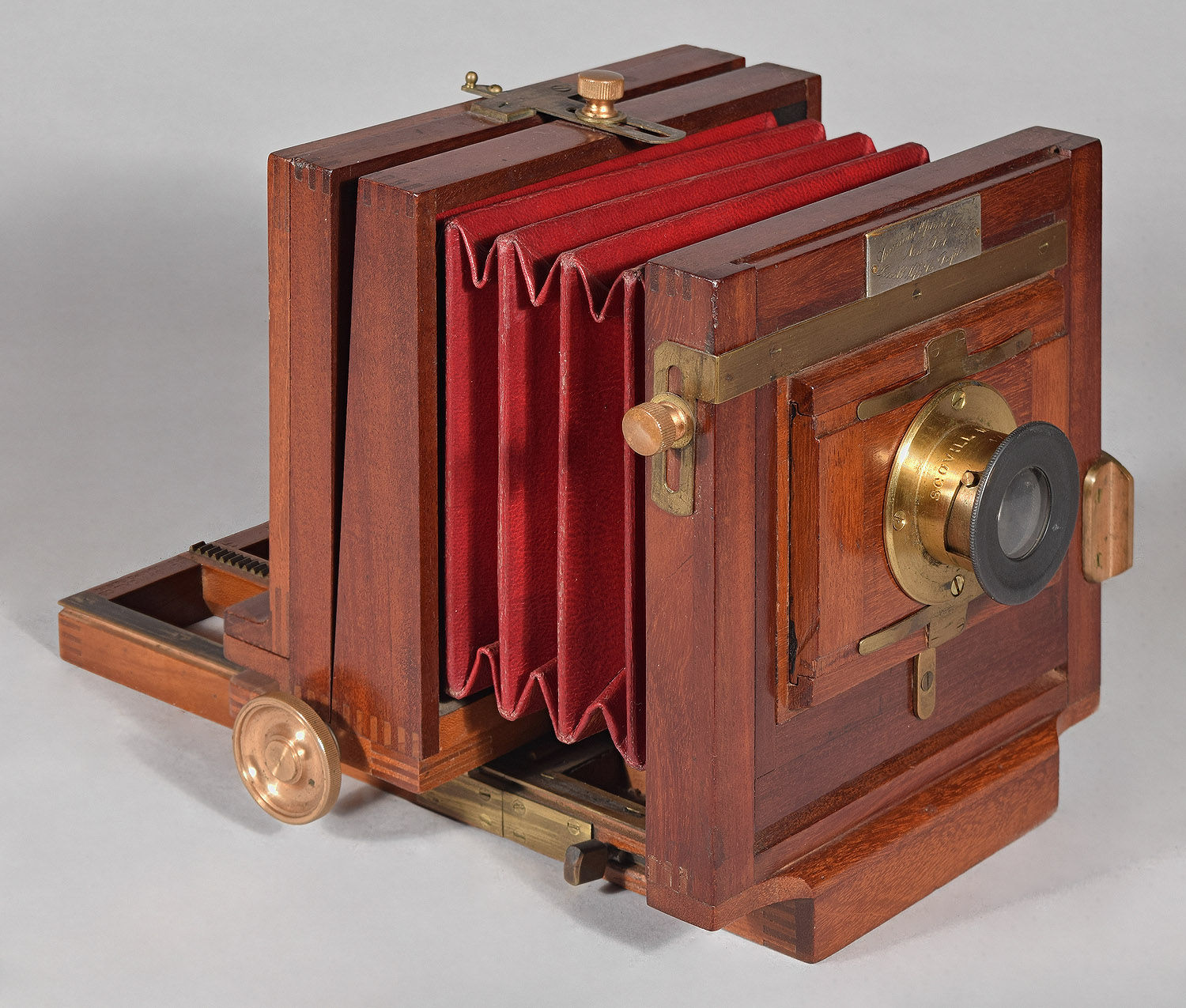
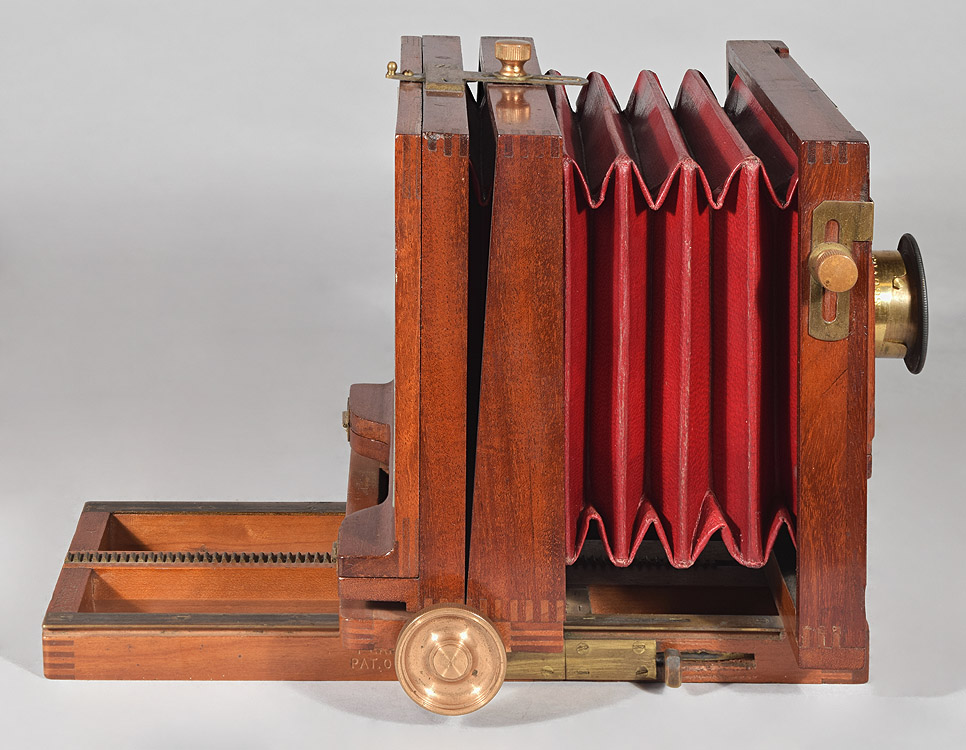
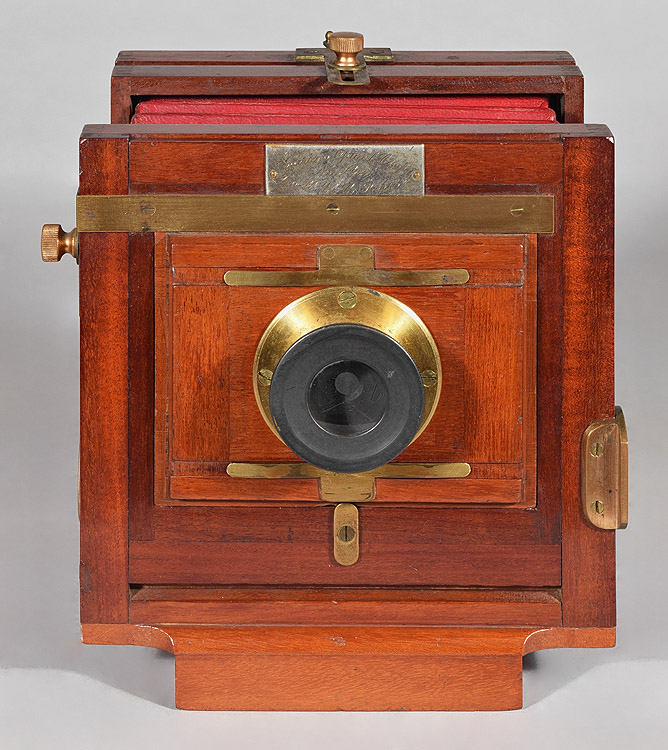
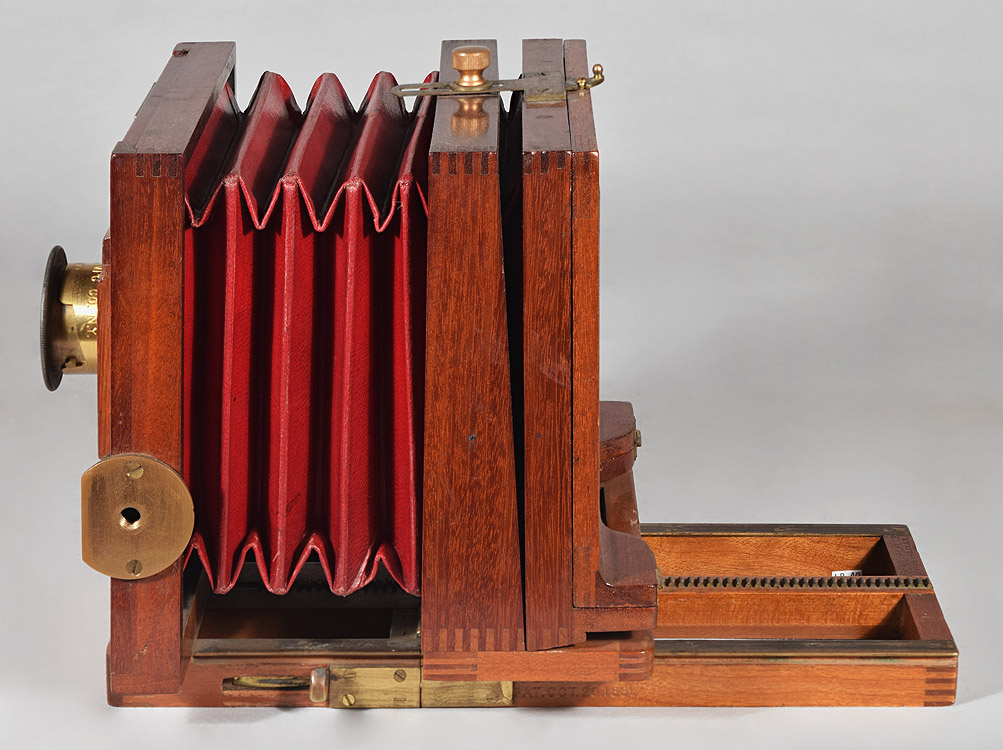
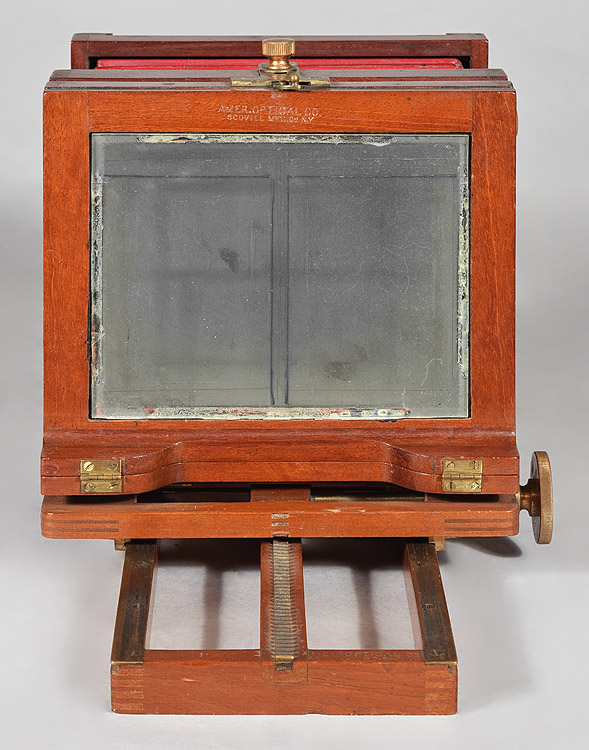
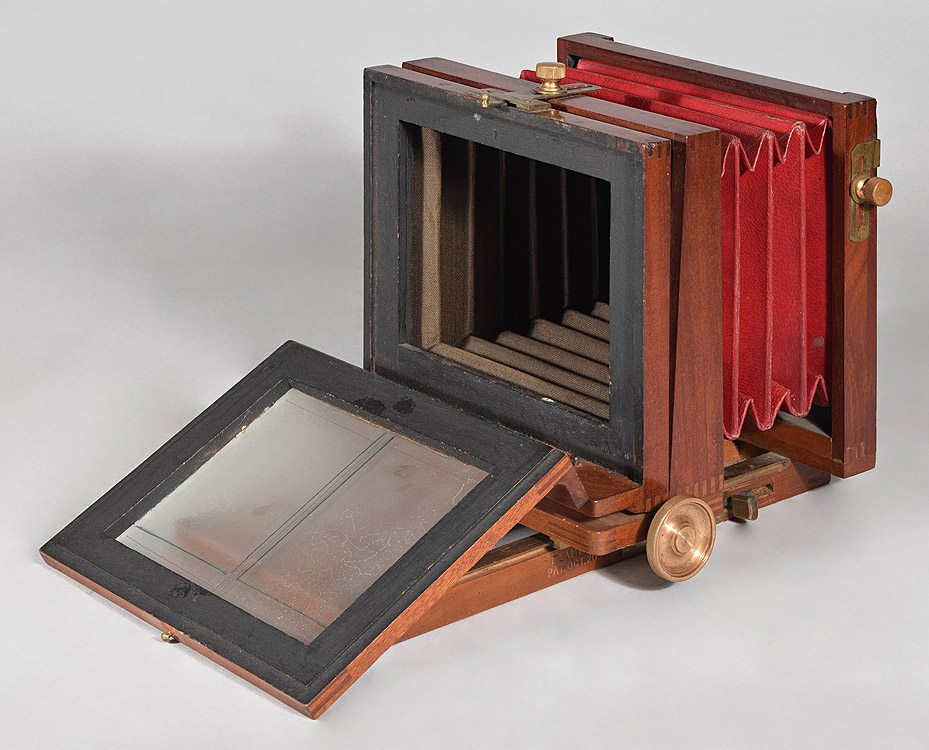
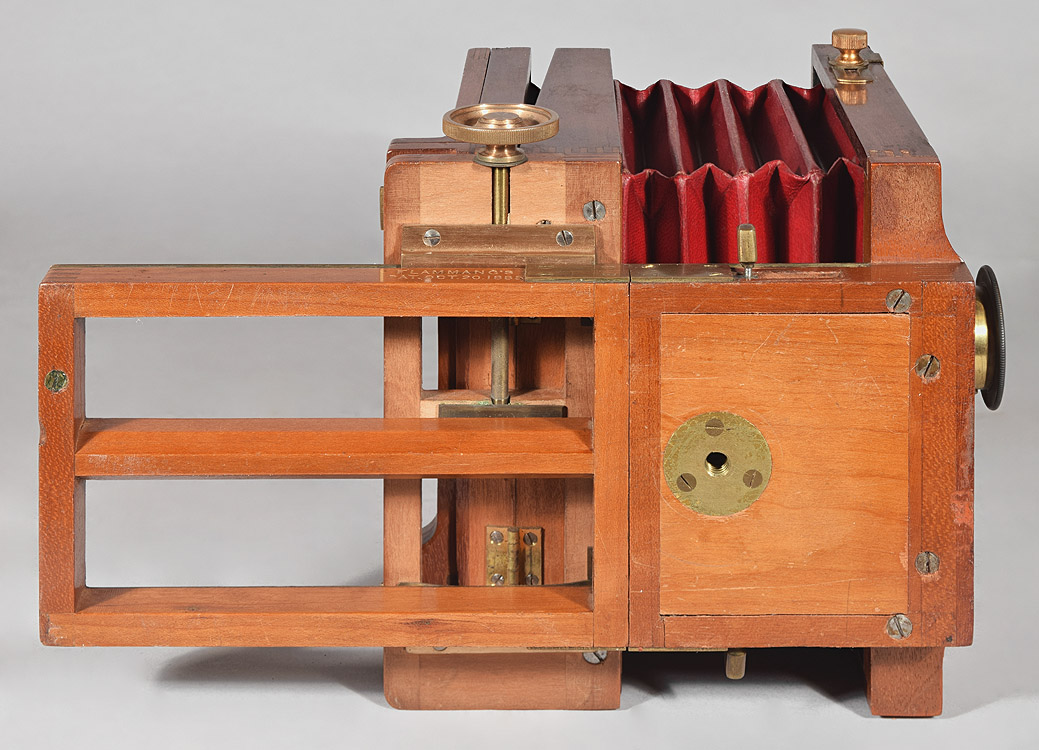
Label on front standard

Stamp on ground glass frame

Stamps on rear base rail

Flammang's patent bed rigidizer
and stamp, side rails

Another American Optical Apparatus Outfit Camera
No. 202 (4 x 5), also known as The 76 Camera.
This example, unlike the one above, has
neither the manufacturer's label on the front standard, nor does it have
either of the manufacturer's stamps on the upper ground glass frame and
the rear of the platform. It is possible that, although made in
the American Optical factory (as shown by the general construction,
finish and the patent Flammang rod and pocket devices on both sides
complete with patent date stamps), it may be a reject or second of some
type that didn't rate the American Optical identifications.

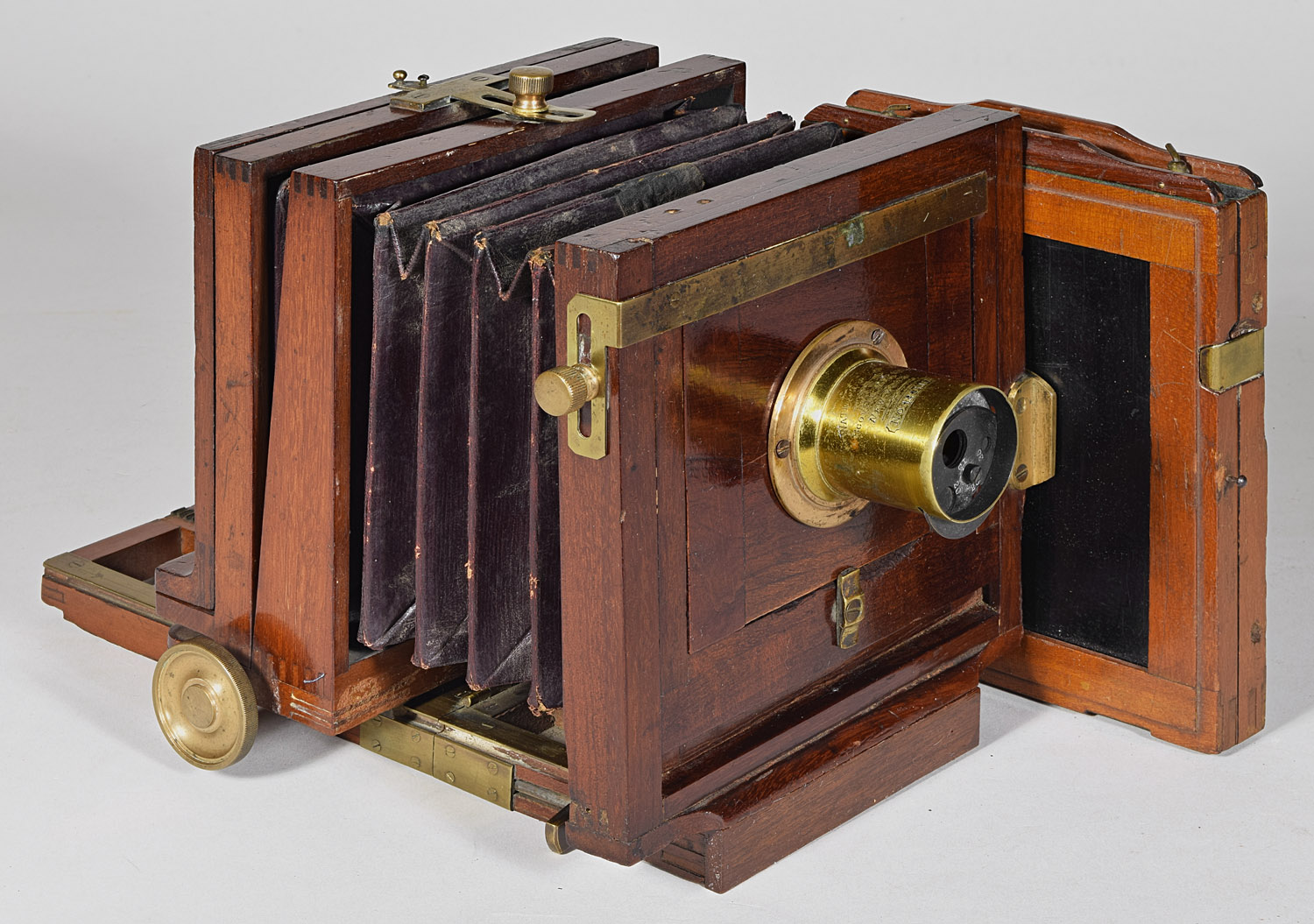
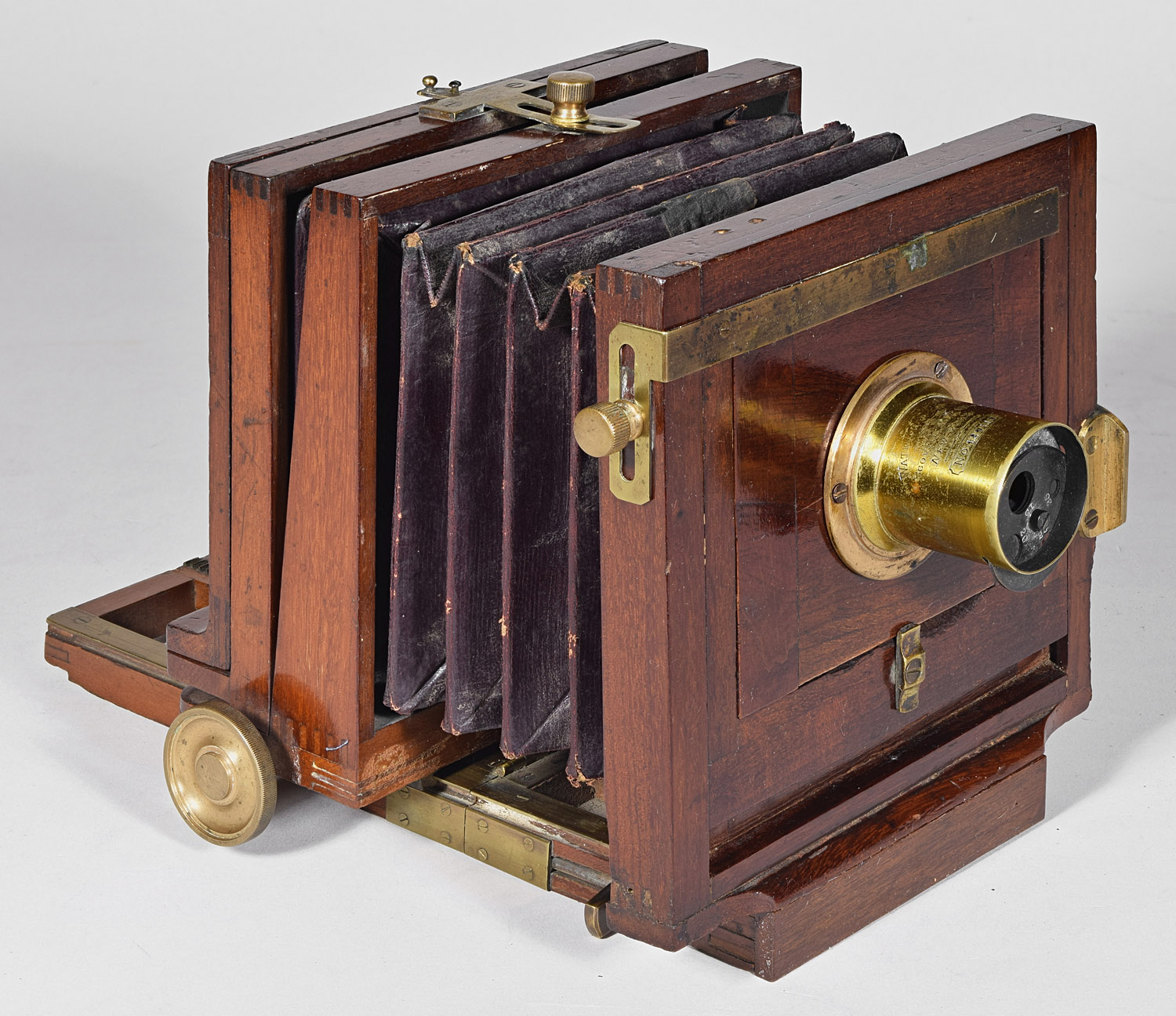
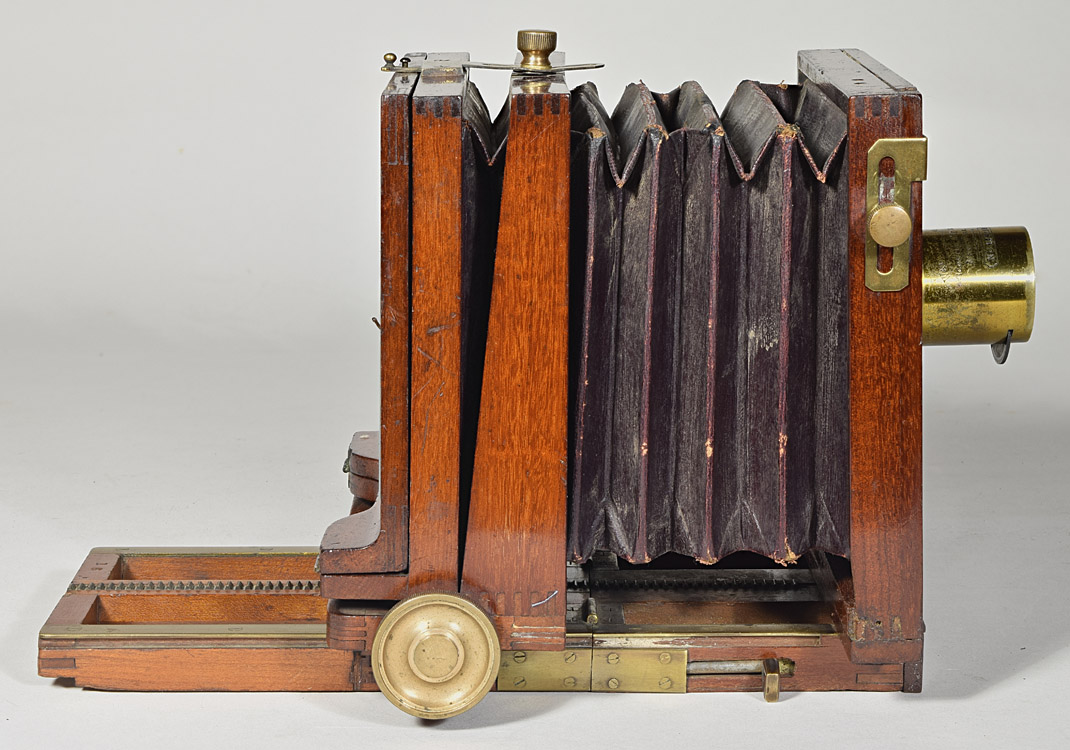
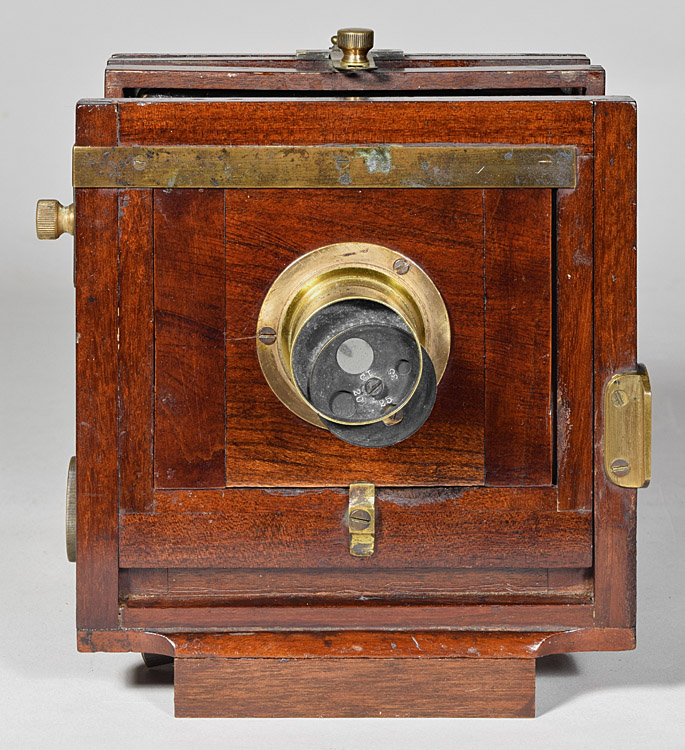
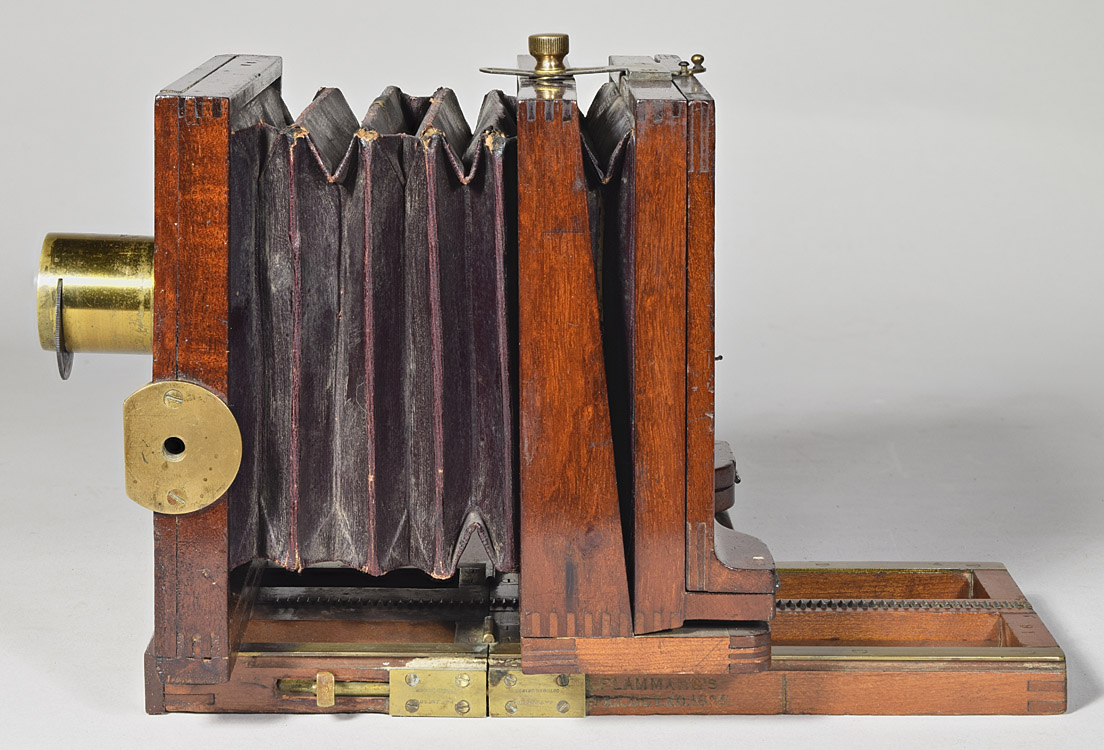
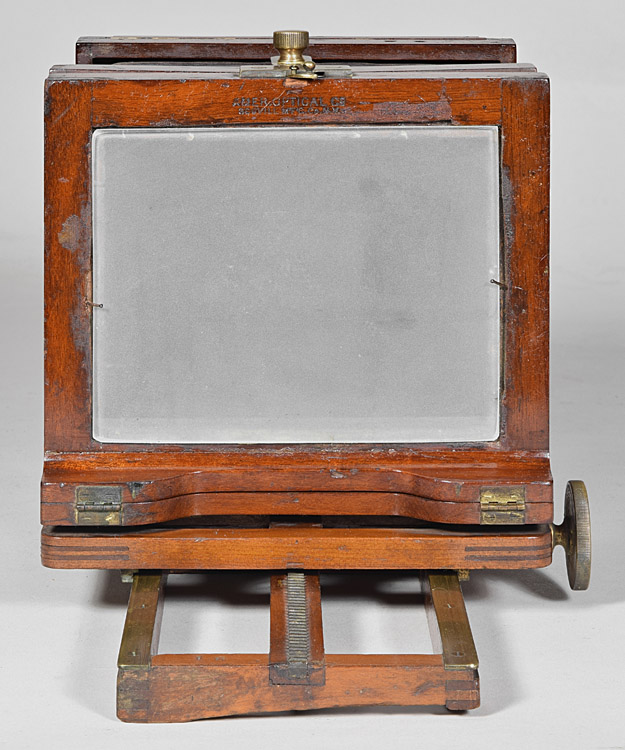
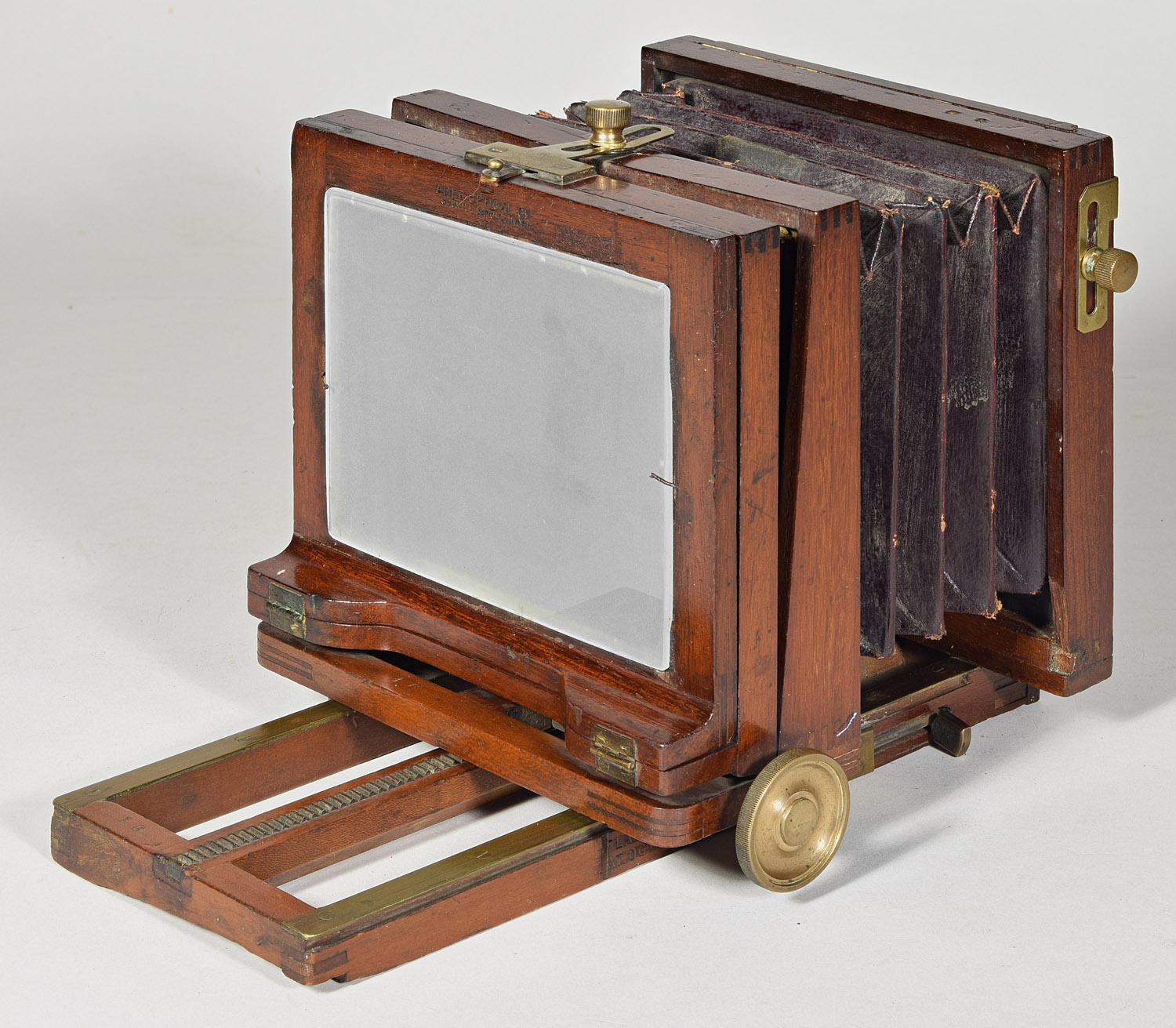
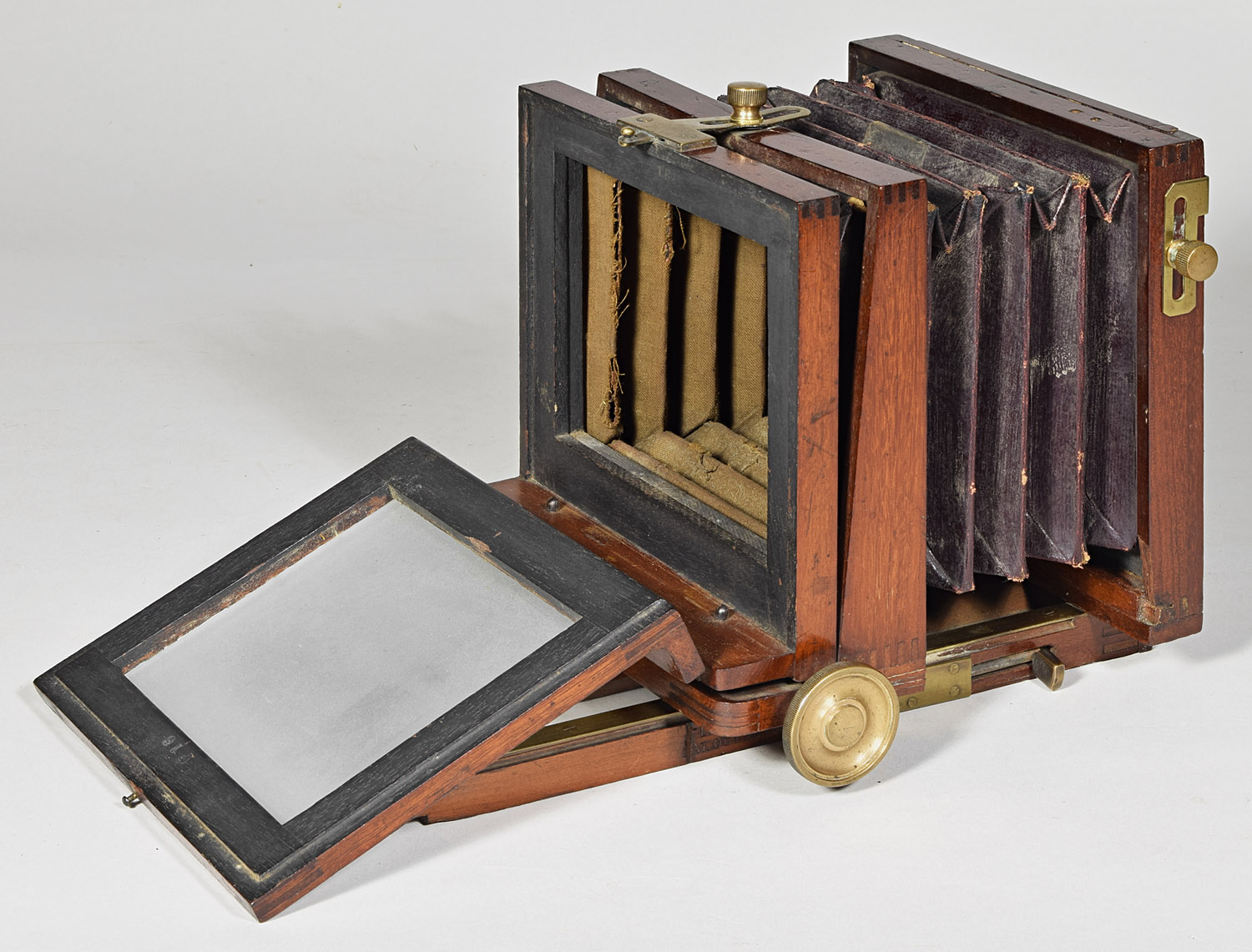
Bottom
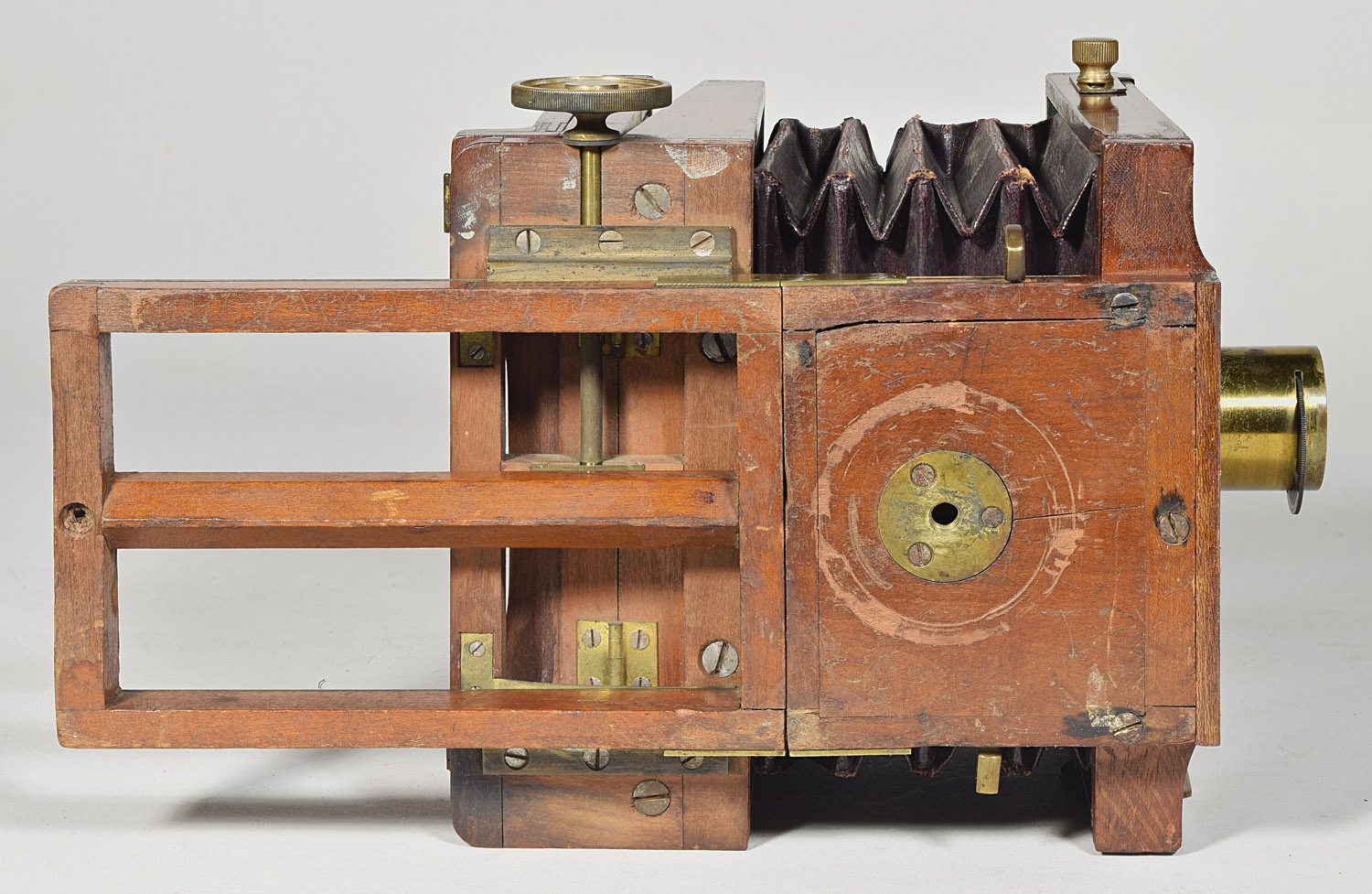
Top
Note that, unlike the first 4x5 example above, this one does not have
any manufacturer's stamp at the rear end of its platform - just an
assembly stamp "16"
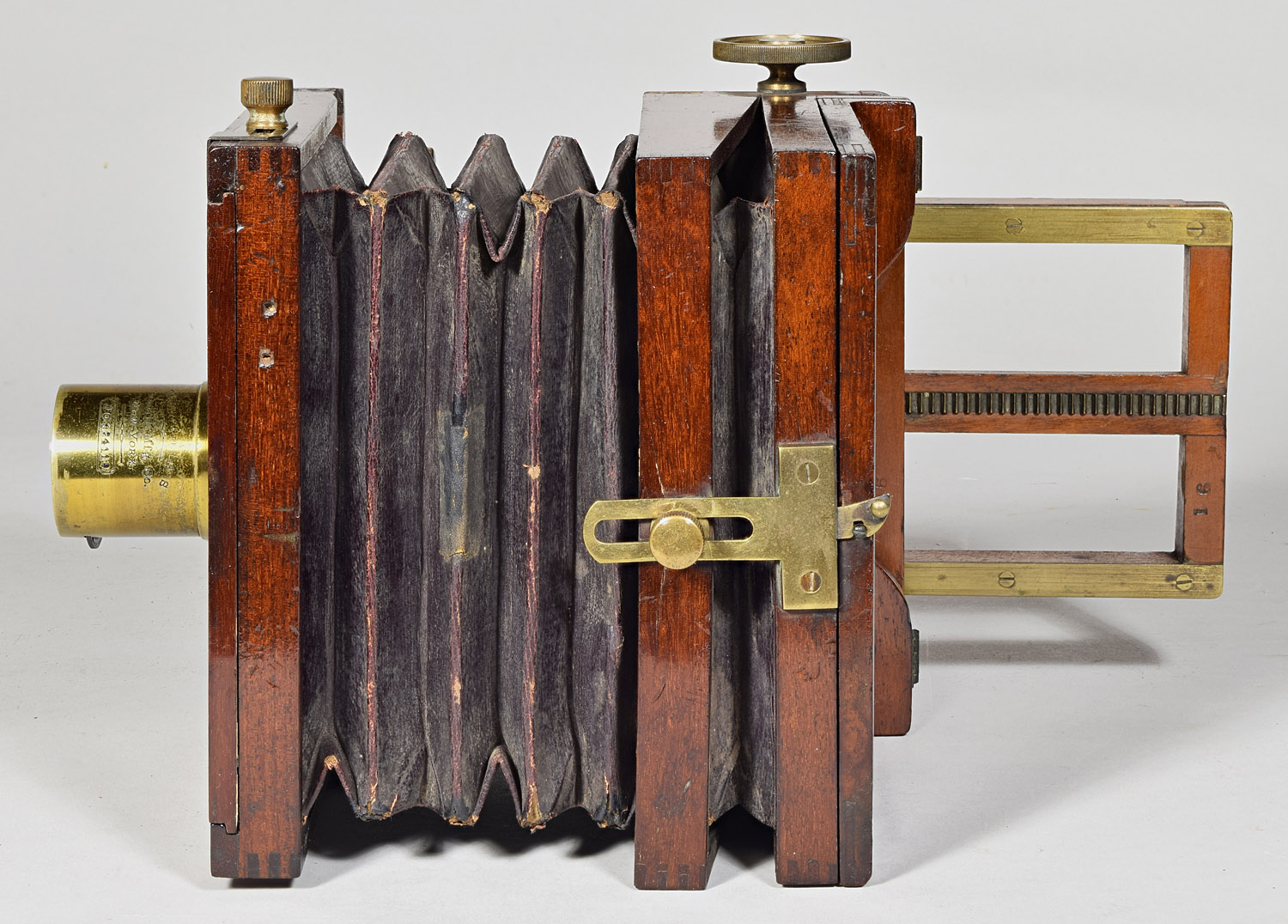
American Optical Apparatus Outfit Camera No. 203 (5 x 8"; also
known as The 76 Camera)
with The
Waterbury Finder on top (finder
reference:
How to Make Photographs and Descriptive
Price List,
Scovill Mfg. Co. (New York, NY),
distributed by Andrew J. Smith (Providence,
RI),
1886,
p. 84)
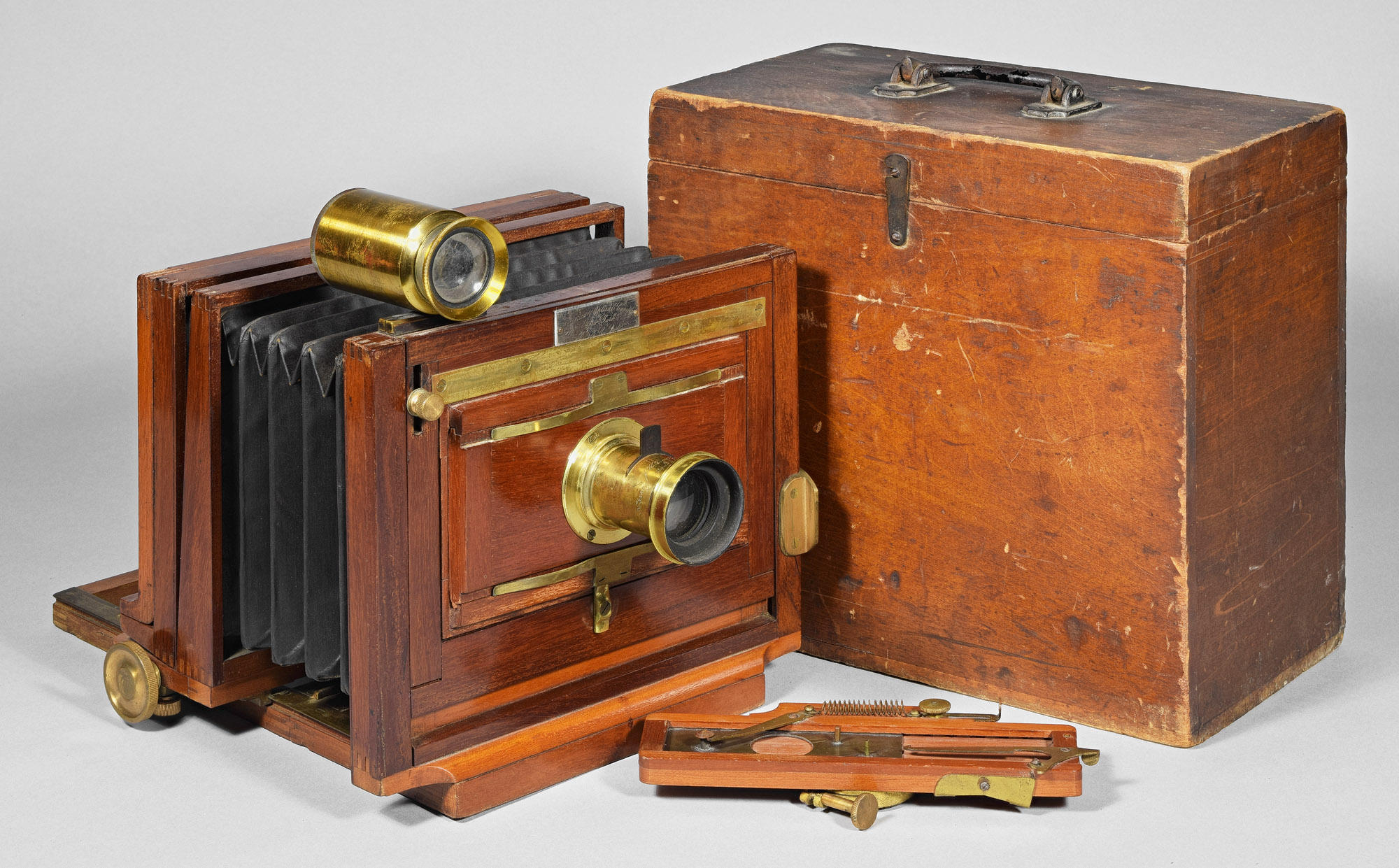
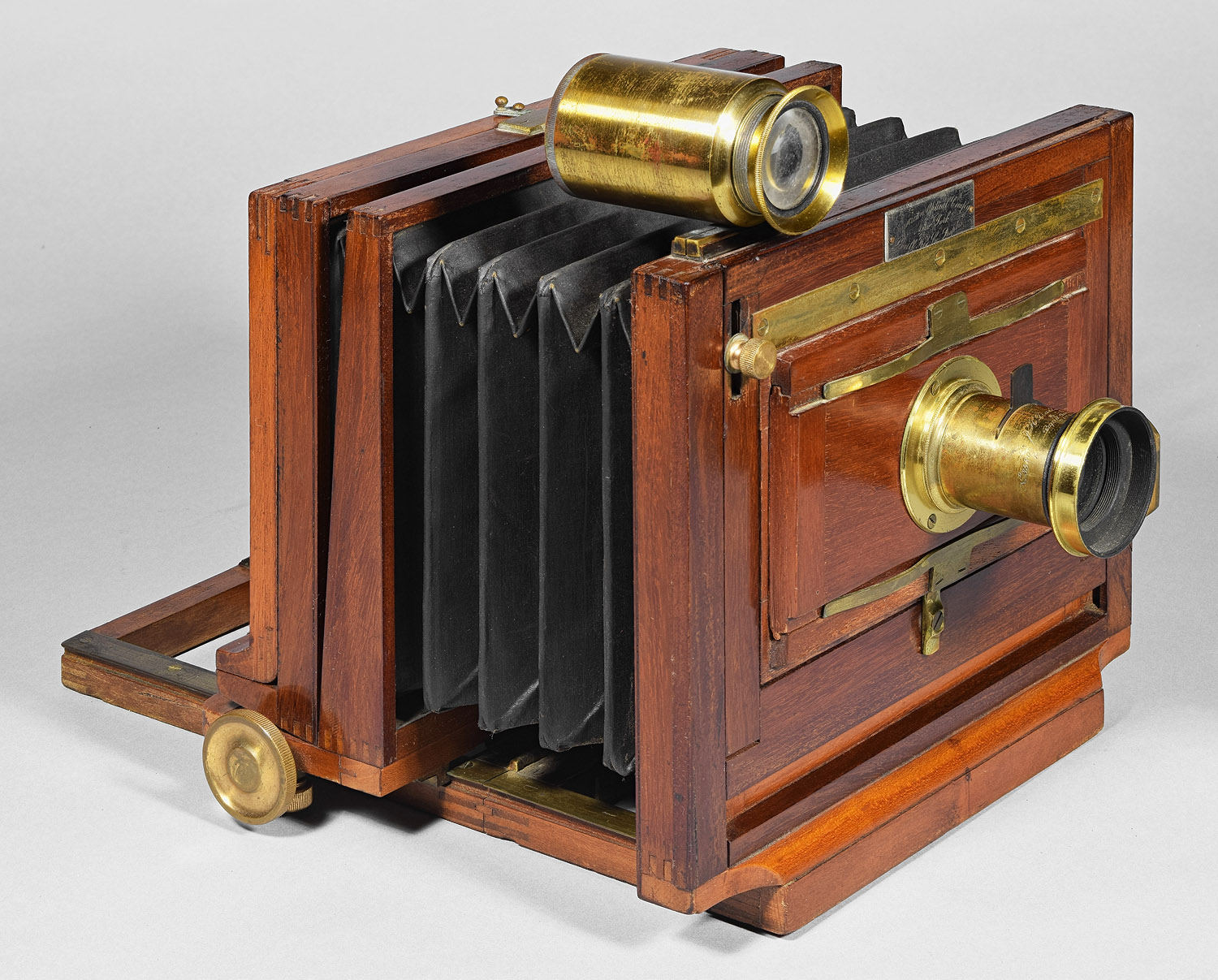
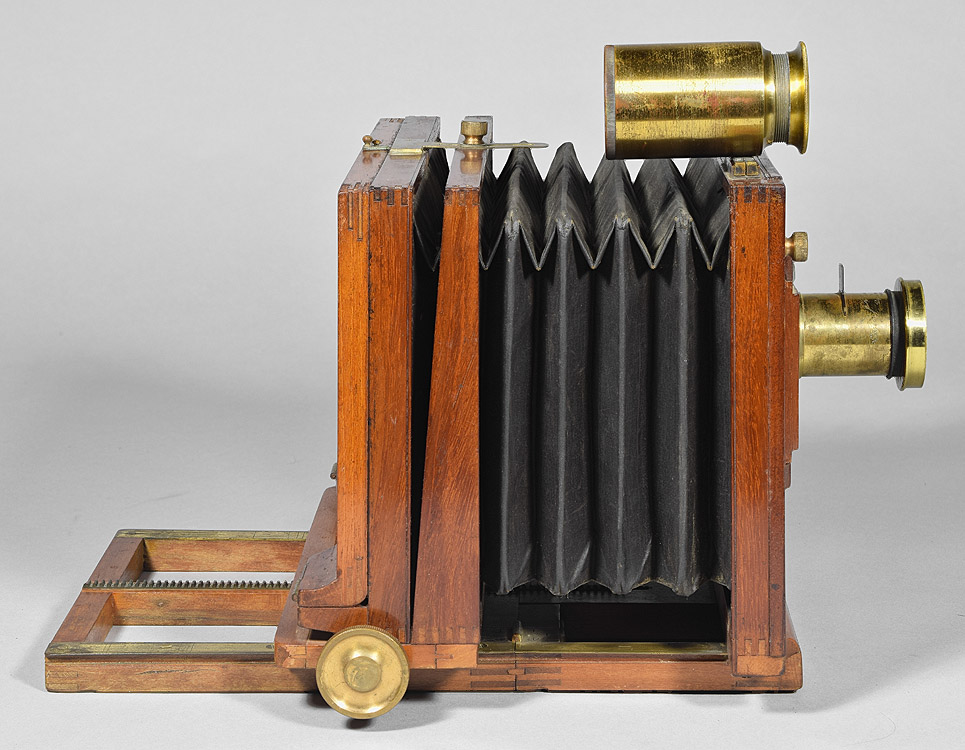
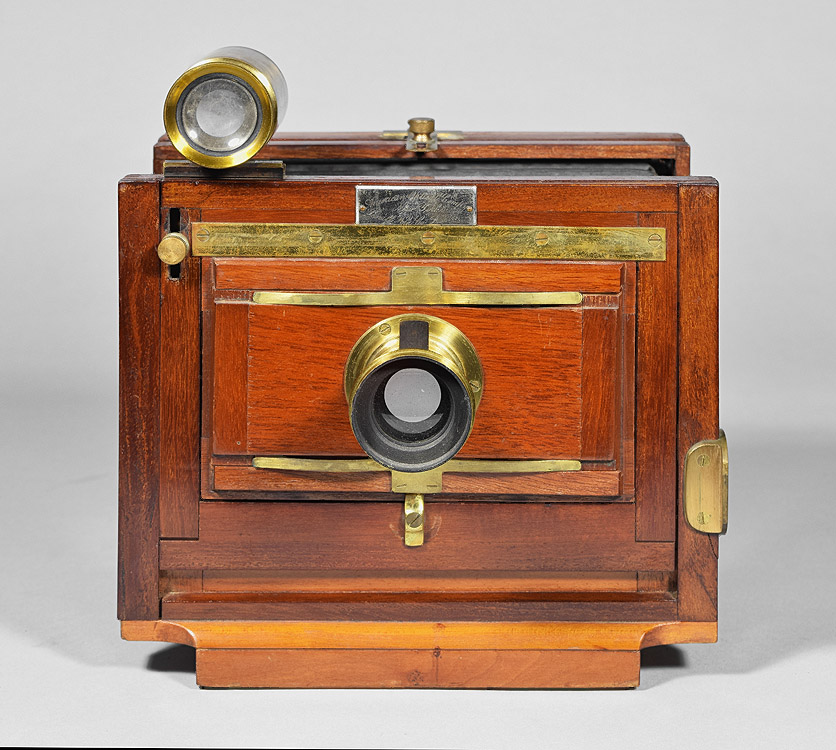
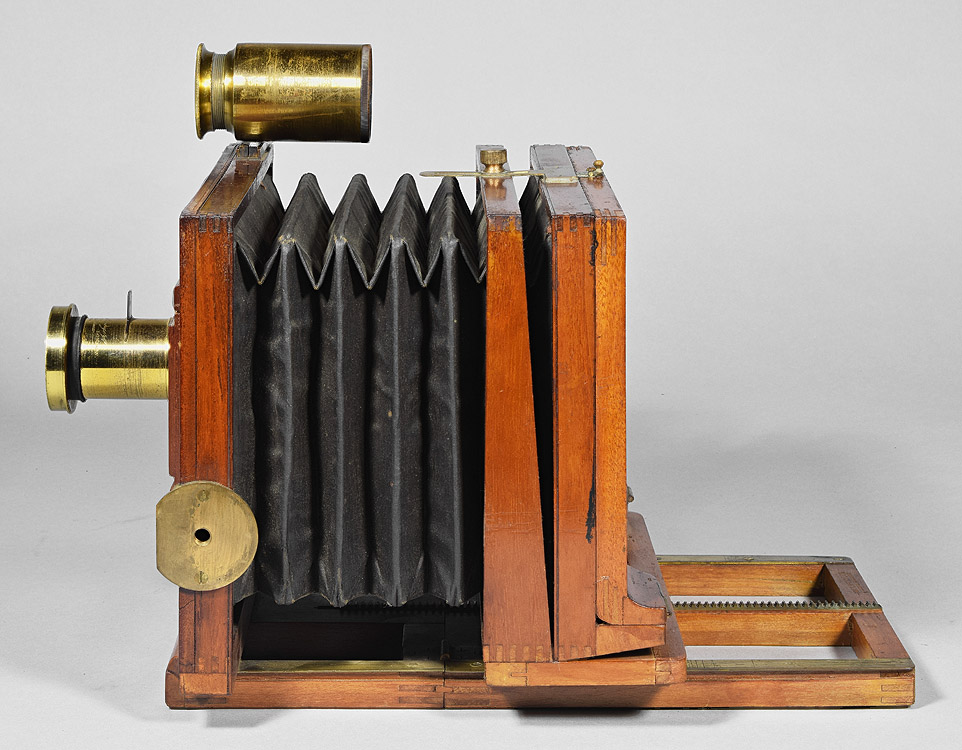
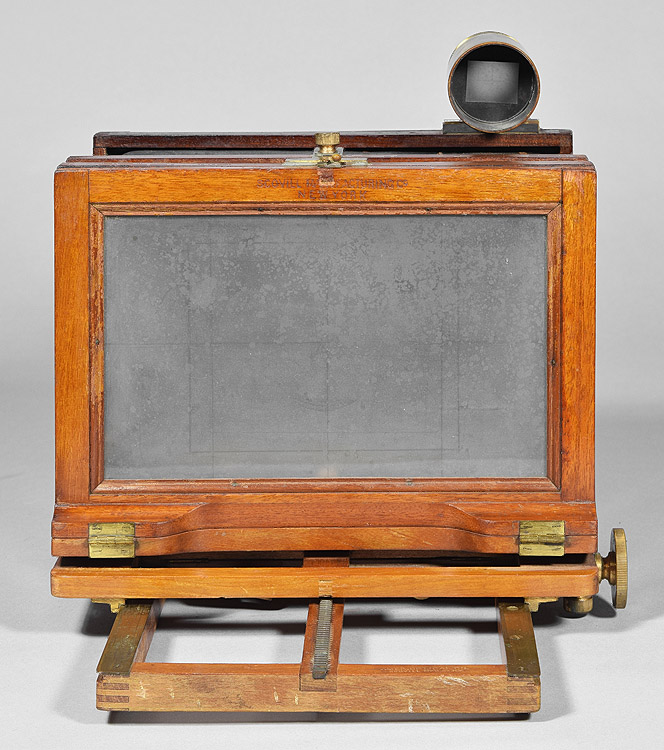
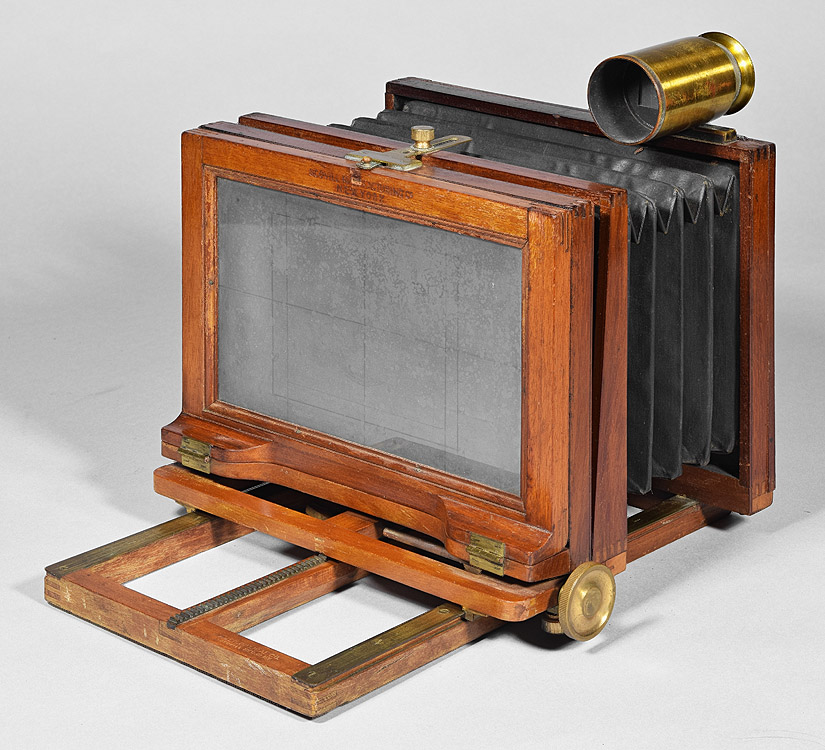
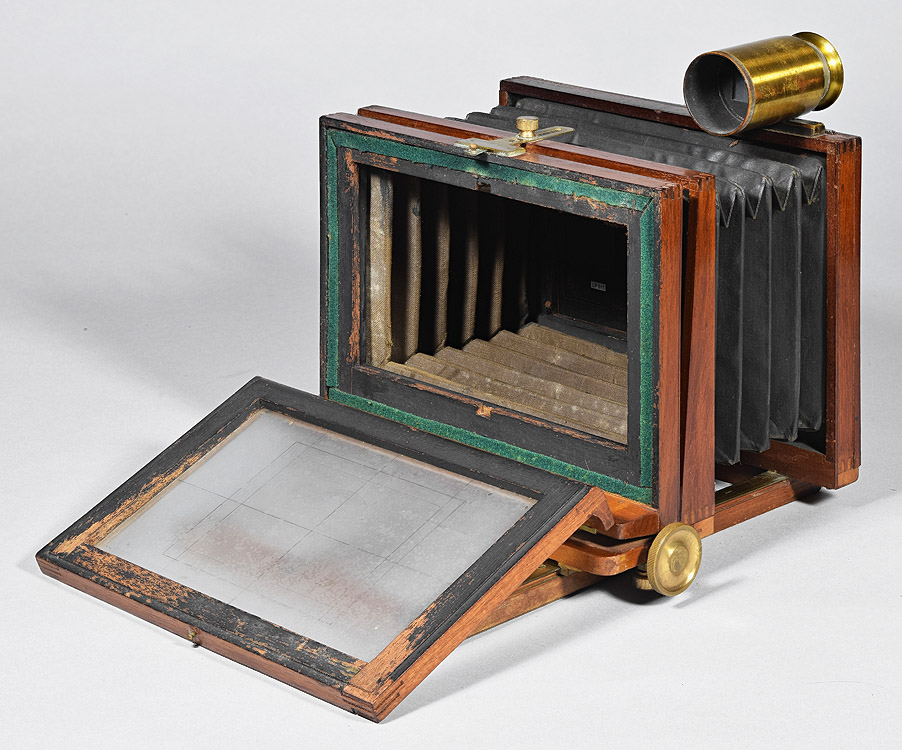
Metal
Label, top of front standard: "American Optical Comp'y New
York Scovill Mfg. Co., Proptrs.
Stamp,
rear of platform:: "Amer. Optical Co. Scovill Mfg. Co. N.Y."
This camera appears to be the American Optical Apparatus Outfit Camera
No. 204 (6½ x 8½"). I say appears to be
because 1) they are extremely rare in such large sizes, and 2) the front
had to be reconstructed, due to it missing the sliding front rise piece
and hardware as well as the lens board. However, the
reconstruction is thought to be on solid ground in that, even though the
brass strip that bends around the edge of the front standard was missing
when purchased, the screw hole on the side of the front standard was
present. The only difference between this and other 76 cameras is
that the trim on the front standard (original, not reconstruction)
extends lower than the bottom of the box-jointed part of the front
standard - never have seen that before on any American Optical or
Scovill camera.
Manufacturer:
American Optical Co. New York, NY factory
The 76 Camera (whichever name is used) is basically a Scovill or
American Optical model view camera that has rack and pinion rear focus,
non-tapering bellows and made from a French polished mahogany.
Specific characteristics of the model and of variations are given below.
Above are
illustrated
The 76 Camera
Variation 1 4x5" and 5x8" examples.
Note the
slight variation in hardware to raise or lower the lens board. The
5x8" example was probably made prior to 1886, since it lacks the
patented rod and piston device to make the platform rigid. The 4x5
example was made in 1886 or later. It has the patented rod and
piston device; it also has red leather bellows, and a slightly different
piece of hardware to raise or lower the lens board.
Names: No. 201
= 4x4 (1876-1882)
Usually, the outfits, whether
Pocket or
Dry Plate
or Centennial,
did not come with a lens. In 1890-1891, No. 202 had an option to
be paired with an Optimus
Instantaneous Lens, which,
strangely enough, is not advertised in the catalogs in which it is
mentioned.
Construction
Common to All 76/Centennial
Variations:
Variations: There are five variations , four of which are
marked as products of American Optical Co. via a prominent
silver-colored label, and one of which appears to
be a Scovill version of the American Optical product. This
American Optical vs. Scovill version dichotomy also appears to occur amongst
camera variations known as Waterbury
Cameras. See Waterbury Camera
Variation 1 for the details as well as links to all the
Waterbury variations. The 76
Camera Variation 1.0 (Wet Plate Version)
The 76 Camera Variation 1.0
differs from the archetype
Variation 2.0 by possessing the
push-pull focus rather than rack and pinion discussed above. This
type is very rare, though, and so is not considered the archetype
76 Camera.
It no doubt is earlier than Variation
2, as it is a wet-plate camera.
The first description of The 76
Camera, in 1876, states that the
camera had a fine-focus screw - a piece of hardware that combines one
thumbscrew for firmly setting the rear standard at one spot, and another
thumbscrew that allows fine-focusing (see
American Optical View
Camera Boxes No. 1 (view from the right and behind).
Therefore, Variation 1.0
is intermediate to the fine-focus screw
76 Camera
and the rack and pinion focus 76
Camera Variation 2.0. It is
no wonder that the engravings don't quite know what type of focus to
illustrate: there were three types of focus made very close in time to
one other.
The push-pull focus on this
variation is secured by a lever on the back of the rear standard.
When rotated in the clockwise direction until pointed straight back, the
rear standard moves freely. The lever can be used as a handy item
to pull on to achieve the desired focus. When rotated further
clockwise, the lever binds tightly to prevent the focus from moving when
the plate holder is inserted or removed. It does not appear to have a
stamped assembly or serial number. The camera is indeed from
the 1876-1881 wet plate era, as shown by the last photo above, taken of
the surface directly below where the plate holder sits during an
exposure. Black stains, undoubtedly stains from the
silver-halide-containing collodion, are visible - just where they
commonly are found on cameras in which the wet-plate process was used.
Assuming that the earliest 76
Cameras had fine-focus screws as
described, this camera is mostly likely from about 1878-1881.
The sizes of Variation 1.0,
Variation 1.2,
Variation 1.5
and
Variation 3.0
are large - significantly larger than the size of
Variation 2.0 (see
Variation 3.0
for discussion of size).
The 76 Camera Variation 1.2 was
only found after the identification and naming of the
76 Camera Variation 1.0
and the
76 Variation 1.5. It
turns out that it has one characteristic of
Variation 1.0
and one characteristic of
Variation 1.5
- therefore, it has been desitnated as
Variation 1.2. The
feature exactly like that in
Variation 1.0
is that they both have a rounded yet flattened wood molding at the
bottom of the front standard, whereas all other variations of the
76 Camera
have a molding that is exactly quarter-round. The feature like
that in
Variation 1.5
is that they both have (as do all
76 Camera
variations except
Variation 1.0) rack and
pinion focus rather than push pull. Unklike the other variations
having rack and pinion focus, the focus knob of
Variation 1.2
has a plain surface; the focus knobs of the other rack and pinion 76
Cameras have a stepped embellishment.
It has a
stamped assembly or serial number "6" on the upper rear surface of the
platform, and on the upper rear standard under the ground glass frame. The example camera has a
replacement lens board; it original probably would have been a
shifting-type, as advertised for the the
76 Camera.
The 76 Camera
Variation 1.5 (Early Plate Holder Clip Version) The
76 Camera Variation 1.5
appears to be identical to the 76 Camera Variation
1.0 as far as type of
wood, grain and finish and hardware design and finish, except for 1) the
substitution of a quarter-round molding for the rounded yet flattened
type, and 2) a unique clip and catch that together hold the plate holder to the top of the rear standard.
Fortunately, the camera example has with it a matching plate holder, so
the design can be fully appreciated. The bottom of the plate
holder has two holes that fit over corresponding wooden pegs at the
bottom of the rear standard, as do many other cameras of the era, but
the clip (and associated catch) at the top of the rear standard is
unique. Other variations of the 76 Camera (as
well as many other models and variations of Scovill and American Optical
cameras have a simple spring-loaded, horizontally-acting clip that engages
a simple round head screw shaft on the upper edge of the plate holder (also
the lower edge, since the plate holders are double-sided).
However, the 76 Camera Variation 1.5 has a more complex arrangement for
the upper clip and catch. The clip is spring-loaded, but is
vertically acting, slipping into a small incised hold and engaging a
shaped brass catch that is imbedded in the hole. The same
arrangement must be made on both sides of each plate holder. It is
a very elegant solution to keeping ground glass up and installing the
plate holder, but no doubt much more expensive to produce than the later
catch and wood screw arrangement. But even the
Variation 1.0 and
Variation 1.2, thought to be
earlier examples, have the simpler wood screw catch. It is unknown
why this camera has the fancy clip, and good luck finding another plate
holder. The 76 Camera
Variation 2.0 is the archetype
76 Camera, in that it most 76
Cameras extant seem to be this variation, and that this
variation matches the engravings and descriptions in catalogs most
closely. But this is advertising in the 19th century, and
engravings often don't match the actual camera model in detail. Considering this, if
the written description of a model differs from an engraving of the
model, the written description should be considered to be the more
accurate. Given this, the written description of The 76 Camera has
the following: mahogany, polished finish, folding bellows and
body, single swing, hinged bed, and brass guides. The engravings
show a shifting lens board - something worth mentioning in the written
description, one would think. The engravings also show a push-pull focus
The presence or absence of rack and pinion focus is not in the written
description, although one engraving (from the viewpoint of the back
right side) suggests a rack and pinion in that it shows a large
thumbscrew that corresponds to the thumbscrew for rack and pinion focus
on the example cameras. However, the same engraving clearly
illustrates a push-pull focus. This discrepancy was never
corrected, despite appearing in advertising for almost two decades. The actual camera
differs from the engravings only on the above last point of type of
focus, The vast majority of example
76 Cameras observed so far are rack and pinion focus
(push-pull versions must be very rare, as they are so far unique
examples having no peers. Given that the brass guides are required
for a single track rack and pinion to function adequately (and expensive
enough to not appear on any but the most expensive field cameras), and
the lack of American Optical manufactured examples, I am of the opinion
that rack and pinion focus is part of The
76 Camera archetype. The focus is secured by a
thumbscrew that is underneath the large thumbscrew, and is only visible
on the photo taken of the 5x8" example from the right side. The
4x5 example has no such thumbscrew, and has to rely on the resistance of
moving the rack and pinion to not change focus while inserting or
removing the plate holder, a system which probably did not function
well. The wood appears to be
naturally dark, Cuban mahogany, of a rather plain, straight grain
figure. The hardware has the draw-file finish, and screw heads are
aligned, as can be seen from the eight screws in the Flammang patented
rod and piston device on the 4x5 example above, in which five are
aligned and the other three probably have been unscrewed at some point
and put back in mixed up order. In summary, the camera is just
what is to be expected of an American Optical manufactured product; the
corroborating label and stamping are merely icing on the identification
cake.
Variation 2.0 has a stamped assembly
number on the rear of the platform. Variation 2.0 is physically
significantly smaller than Variation 1.0,
Variation 1.2,
Variation 1.5 or
Variation 3.0. The 76 Camera
Variation 3.0 (Scovill Version) A third variation
exists that shows almost all of the characteristics common to
76 Cameras,
yet is distinct from the other variations.
This variation matches
Variation 2.0
in that: its construction is the same, its wood is French
polished, its hardware is draw-filed, the screws on the front (the only
place where two or more are next to one another) are aligned, it has a
single track in the middle of the platform for rack and pinion focus, it
has a small thumbscrew under the large focusing thumbscrew whose purpose
is to clamp the large thumbscrew (and thus the focus) securely in place.
It differs from
Variation 2.0
in three ways:
1) Its wood is a light-colored mahogany,
that is very unlike the dark, Cuban mahogany that normally is found in
American Optical products. It is more like the wood found in
Scovill products, such as the Waterbury
View Camera Variation 1. It probably is Honduras
mahogany, a type of wood still available today from tree farms. 2) The lens board is a simple three-piece
type that does not shift, rather than the shifting lens board found on
Variation 2.0. 3) It has a ground-glass frame (and thus
bellows and both standards) that is
considerably larger than that of either
Variation 1.0 or Variation 2.0.
Hence the entire camera is also considerably larger. A comparison
of the sizes is shown below. This discrepancy in size between
those cameras thought to have been made in the American Optical factory
and those cameras thought to have been made in the Scovill New Haven
factory is similar to the discrepancy found for the variations of the
Waterbury View
(see
Waterbury View Variation 1
for comparison photos). The difference in construction may be due
to Scovill not precisely duplicating the tools and jigs used to make the
camera in one factory vs. the other. The company may have
merely left the details of construction to the tool- or camera-makers
from each location. It is not that Scovill cameras are always
larger than American Optical cameras; in the
Waterbury example just mentioned,
the American Optical Waterbury Variation 1
is larger than all the Scovill Variations.
4) It has no American Optical label or
stampings. Instead, it has a stamp on the lens board and a stamp
in the rear of the platform that read: "Scovill Mfg. Co., N.Y."
Variation 3
has a stamped assembly number on the lens board, front standard, front
of platform, and also at the rear of the platform.
Because of its wood and
Scovill stampings, The 76 Camera
Variation 3.0 is thought to have
been made by Scovill, most likely in its New Haven factory. This
is despite the American Optical quality wood and hardware finish.
If so, the workers at the New Haven factory knew how to finish a camera
in high style when they wanted to.
Above are
examples of a 4x5" example and a 5x8" example.
Note the
slight variation in hardware to raise or lower the lens board. The
5x8" example was probably made prior to 1886, since it lacks the
patented rod and piston device to make the platform rigid. The 4x5
example was made in 1886 or later. It has the patented rod and
piston device; it also has red leather bellows, and a slightly different
piece of hardware to raise or lower the lens board. The
76 Camera Variation 3.0 fits a very
large American Optical plate holder size (see
Accessories-c.1885 plate holders in case). Its
back is the exact same size as
The 76 Camera Variation 1 (Wet-Plate
Version) , the earliest variation of
The 76 Camera, and the
American Optical
Waterbury-Type Variation 1, a rare Waterbury-Type camera
that is larger than its more common Waterbury brethren. Despite
the fact that the size of the holders is exactly the same as the camera
backs of these two cameras, neither of these cameras has its holder peg
locations exactly the same as the holders just mentioned, demonstrating
that, in this era, not all the parts on these cameras are not
interchangeable. It would take Henry Ford to pioneer that concept.
Comparison of the size of The 76
Camera Variation 2.0
to The 76 Camera Variation 3.0
(Scovill Version)
References:
Back to American Optical
Co. / Scovill Mfg. Co. (alphabetical)

Stamp, top of ground glass frame:
"Scovill Manufacturing Co. New York"
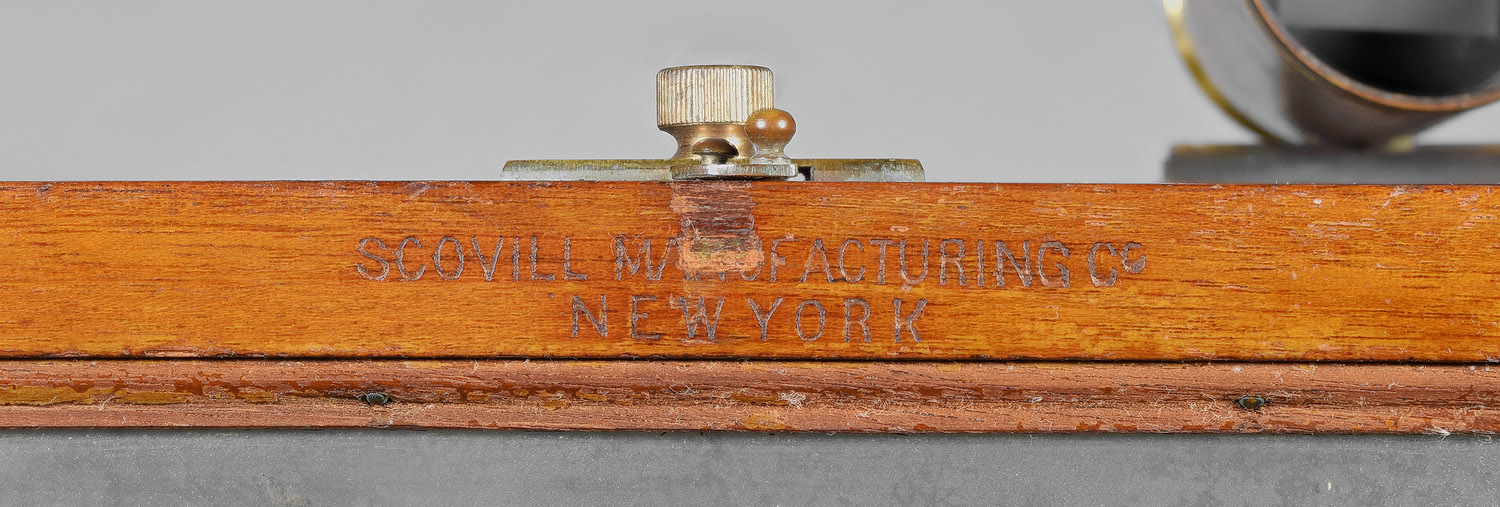

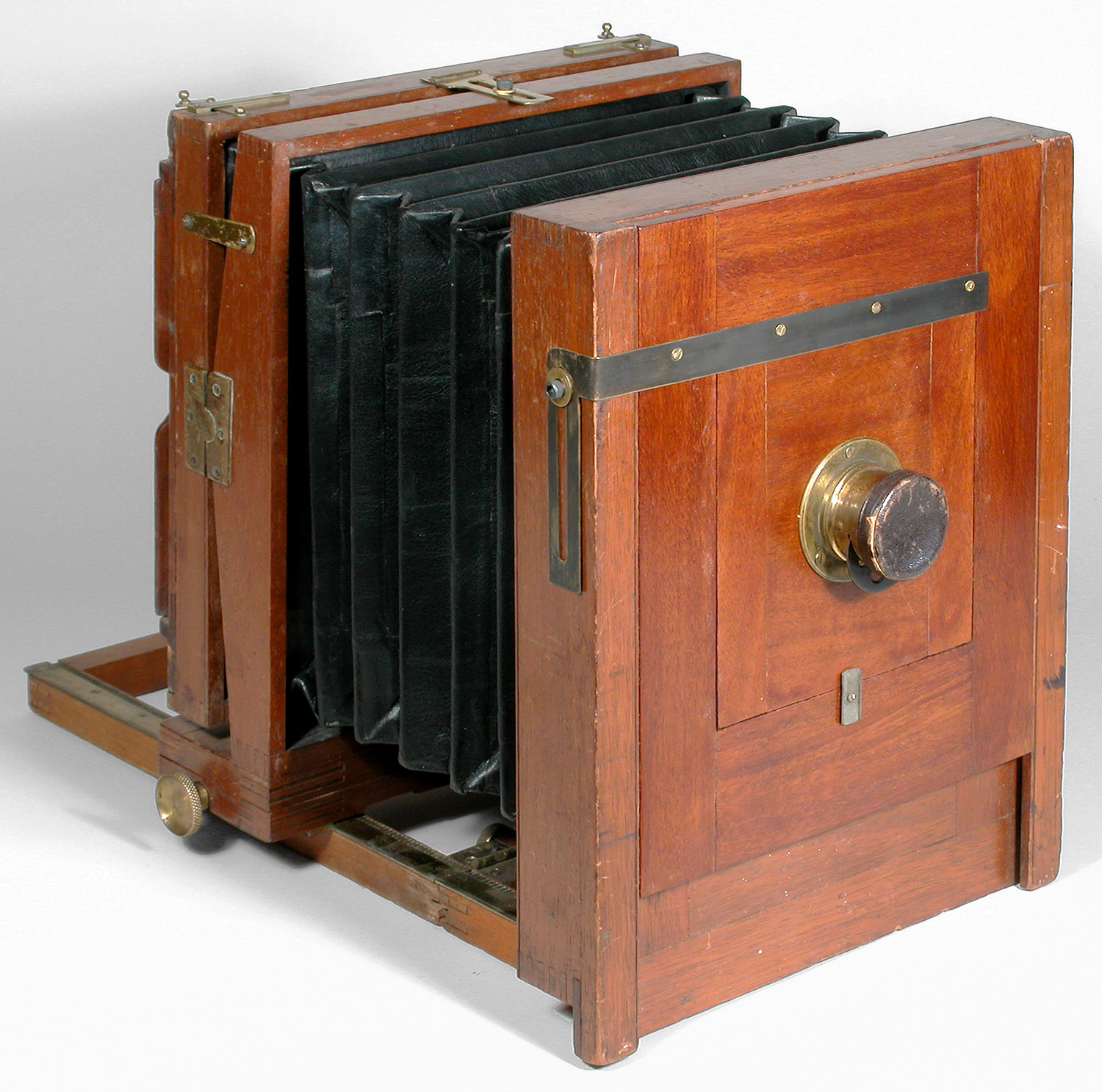
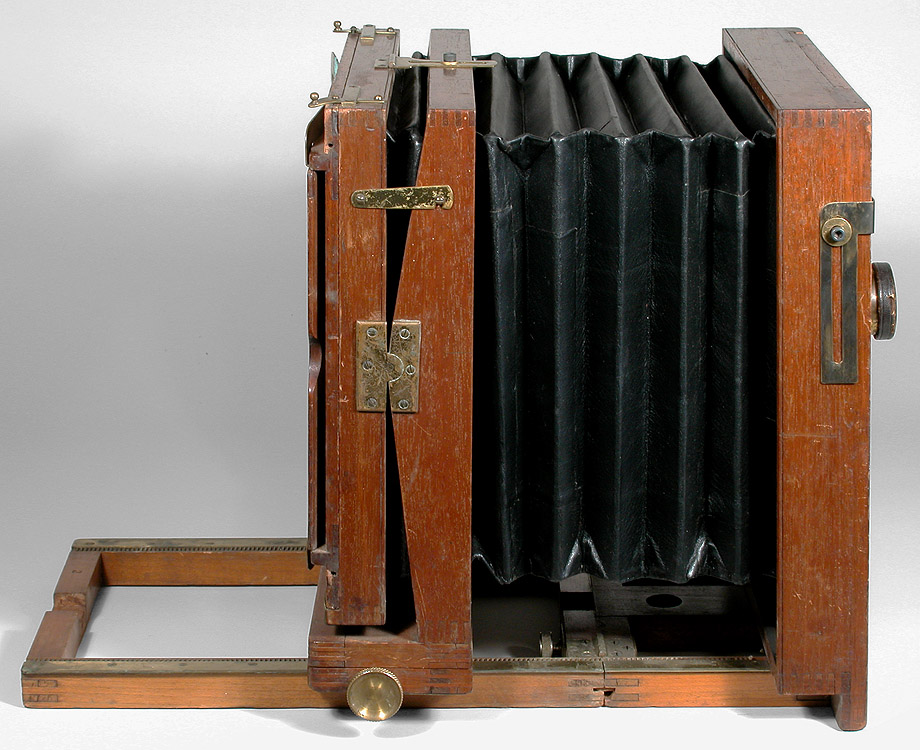
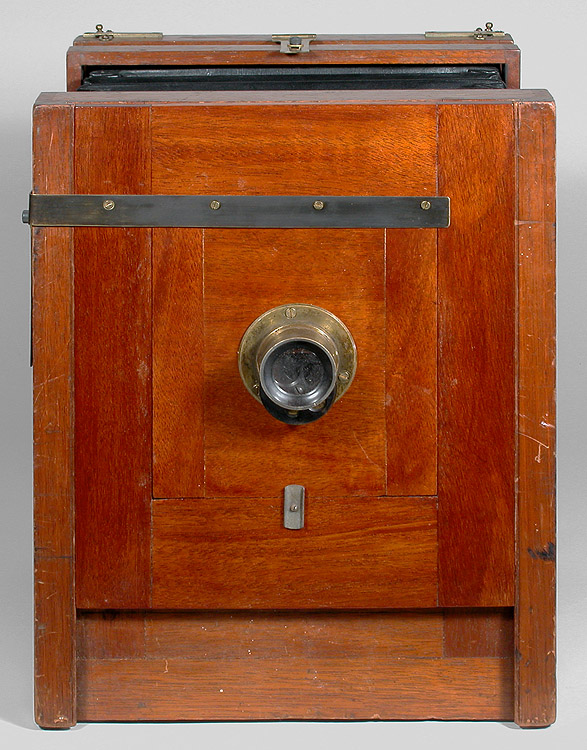
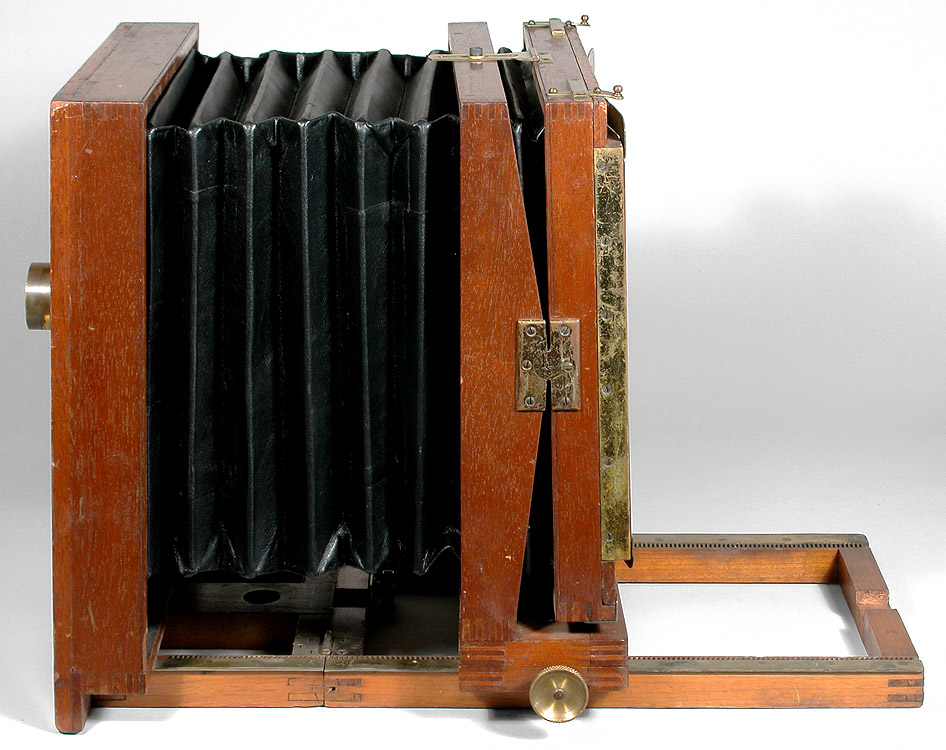
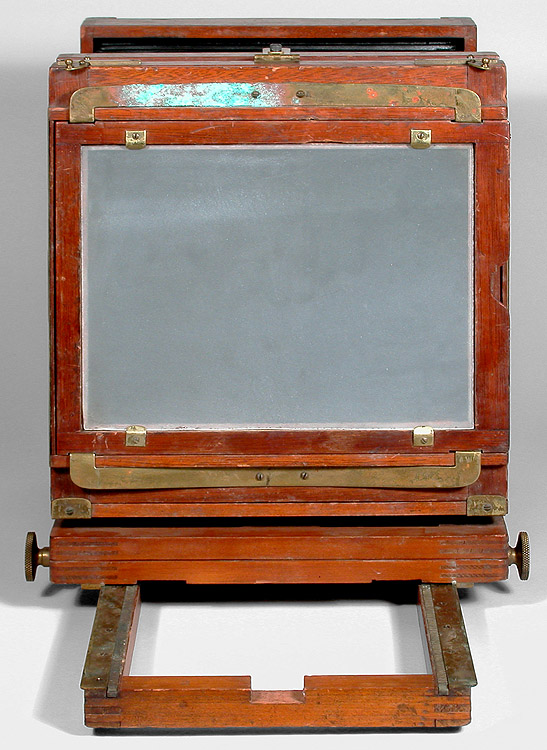
Date Introduced: 1876 ; Years Manufactured:
1876-c.1898
Construction: rear
focus via rack and pinion (single gear track on top
of middle base rail); single swing; reversing
by two tripod mounts; three-piece, shifting lens board
Materials: mahogany body, French polish; cherry base;
black rubberized fabric bellows; brass hardware, draw-file finish
Sizes Offered:
Centennial Outfits: #201=4x4; #202=4x5; #202A=4¼x5½;#203=5x8
(a.k.a. The 76 Camera); #204=6½x8½
Notes:
This long-lived model appears to have been
referred to by a bewildering assortment of names, depending on when and
where advertised. From their introduction in 1875 through about
1881, they were called The Pocket Camera.
From 1882-1886 they were called AO's Dry
Plate Outfits. Starting in 1887, they were called
Centennial Outfits. Adding to the problem is that apparently
only one
size (the 5x8) was given its own special name (The 76 Camera).
The model numbers, No.s 201-204, appear to have been more stable over time
than names (which allows us to put all this nomenclature together).
No. 202
= 4x5 (1876-1883-1885-1886-1887-1888-1889-1890-1891-1892-1896
No. 202A
= 4¼x5½ (1883-1885-1886-1887-1888-1889-1890-1891-1892-1896
No. 202B
= 4¼x6½ (1885-1886-1887-1888-1889-1890-1891-1892-1896
No. 203
= 5x8 (1876-1883-1885-1886-1887-1888-1889-1890-1891-1892-1896
No. 204
= 6½x8½ (1883-1885-1887-1888-1889-1890-1891-1892-1896
Even more confusing,
The Centennial Outfits
were used as a basis for what are called
Instantaneous Outfits,
reflecting the development of faster photographic emulsions that
required the use of shutters rather than the lens cap for exposure (see
e.g.,
How to Make Photographs and Descriptive Price List,
Scovill Mfg. Co. (New York, NY), distributed by
Andrew J. Smith (Providence, RI),
1886, p. 52):
No.401
= Outfit No.202, Peerless lens, wooden drop shutter
No.402
= Outfit No.202, #1 Darlot Rapid Hemispherical lens, wooden drop
shutter
No.403
= Outfit No.202, Morrison's Celebrated B Group lens, metal drop shutter
No.404
= Outfit No.203, #2 Darlot Rapid Hemispherical lens, wooden drop
shutter
No.405
= Outfit No.203, Morrison's Celebrated B Group lens, metal drop shutter
Yet more confusing still, the
Instantaneous Outfits of
1888 abandoned the
No.s 201-204 numbering system,
as well as all sense.
The
76 Camera
(with added shutter to make it instantaneous) was offered as the
No.1 1888
Instantaneous Outfit, the
No.2 1888
Instantaneous Outfit featured
The Petite
Camera (plus shutter), and the
No.3 1888 Instantaneous Outfit featured
The Mignon
Camera (plus shutter).
The 76 Camera is still its 5x8 self, but
note that the Petite Camera and the
Mignon Camera are
both 3¼x4¼", but different quality and prices. The
1888 Instantaneous Outfits
seem to be a hodgepodge.
1) It is back focus only , and has
non-tapering bellows, which results in the front standard being
approximately the same size as the rear standard.
2) The platform has a single rack inlet down the
middle of the platform for rack and pinion focus. The edges of the
platform have "brass guides", sheet brass installed to project slightly
over the edge of the platform. The rear standard, in turn, has a
metal undercarriage with a slot in which the guide moves as the camera
is focused. The guides are a necessary part of a camera having a
single, middle rack and pinion; without them, the focus is hopelessly
wobbly. An exception is
Variation 1.0, which has a
push-pull focus and no brass guides.
Variation 1.0
is thought to represent an early version of
The 76 Camera.
3) The front standard: is a box-jointed square, mounted on a ~1/4
bottom plate, the whole screwed to the front of the main platform; an
~1/4" thick facing holds the rise mechanism and the lens board.
On the bottom of the front standard, there is
a quarter-round trim linking the vertical standard to the horizontal
platform. The front standard adjusts up or down, held in
place by a male knurled thumbscrew.
4) The rear standard: is a box-jointed square, which screwed to a
frame. Even though the frame is the same thickness as is the
bottom plate of the front standard, the rear box has to be slightly smaller
than that of the front standard, since the rear standard frame rides
slightly above the platform on its rack and pinion gear system. A
second and separate box-jointed square in the rear standard is hinged on
the bottom. It tilts backwards to provide a single swing for the
camera. The amount of swing is controlled at the top by a
thumbscrew and slotted
piece of hardware which doubles as a latch for the hinged ground glass
frame.
5) The folding platform or bed is hinged, and made rigid by either
a thumbscrew (pre-1886) or a rod and piston device (patented by
Mathias Flammang Oct. 20, 1885).
6) The bellows on early examples are fabric coated with a black rubberized paint,
red Russian leather (a later example).
7) The ground glass frame hinges down, and is latched up using a
spring-loaded clip which has the same shape and design for all
variations except
Variation 1.2, which is uniquely complex.
8) The lens board consists of a three-piece base on top of which
is a shifting three-piece section. An exception is
Variation 3.0,
which has a simple non-shifting lens board. This camera is thought
to be an inexpensive Scovill version of
The 76 Camera,
and therefore fitted with a less expensive non-shifting lens board. The camera was normally sold
without lens, assuming perhaps that a photographer would want to choose
their own type and brand of lens. Additionally, lenses of view
cameras were hardly permanent, and it is
common to find a camera with a replacement lens board and/or a different
lens, even one made by a competitor.
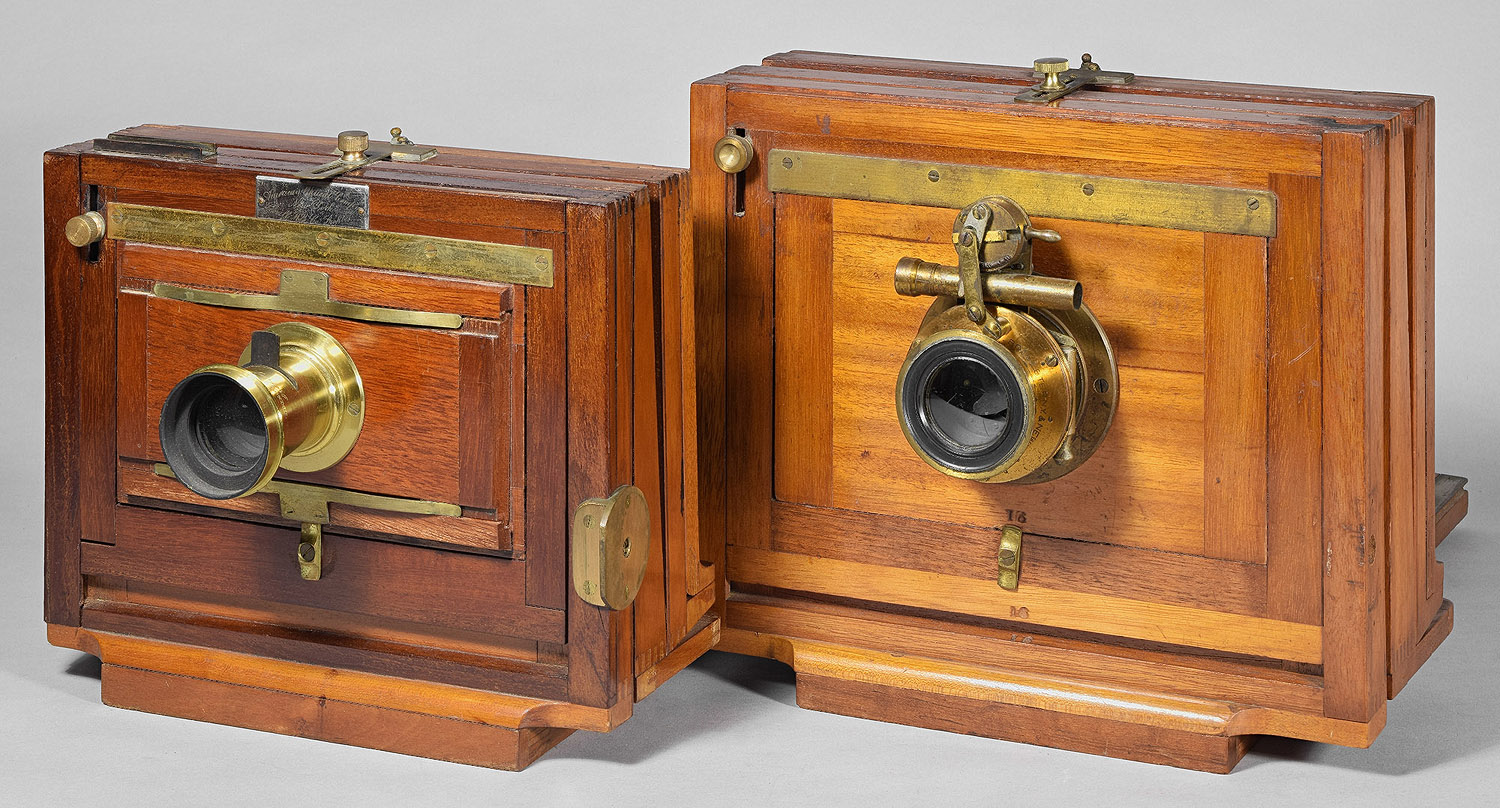
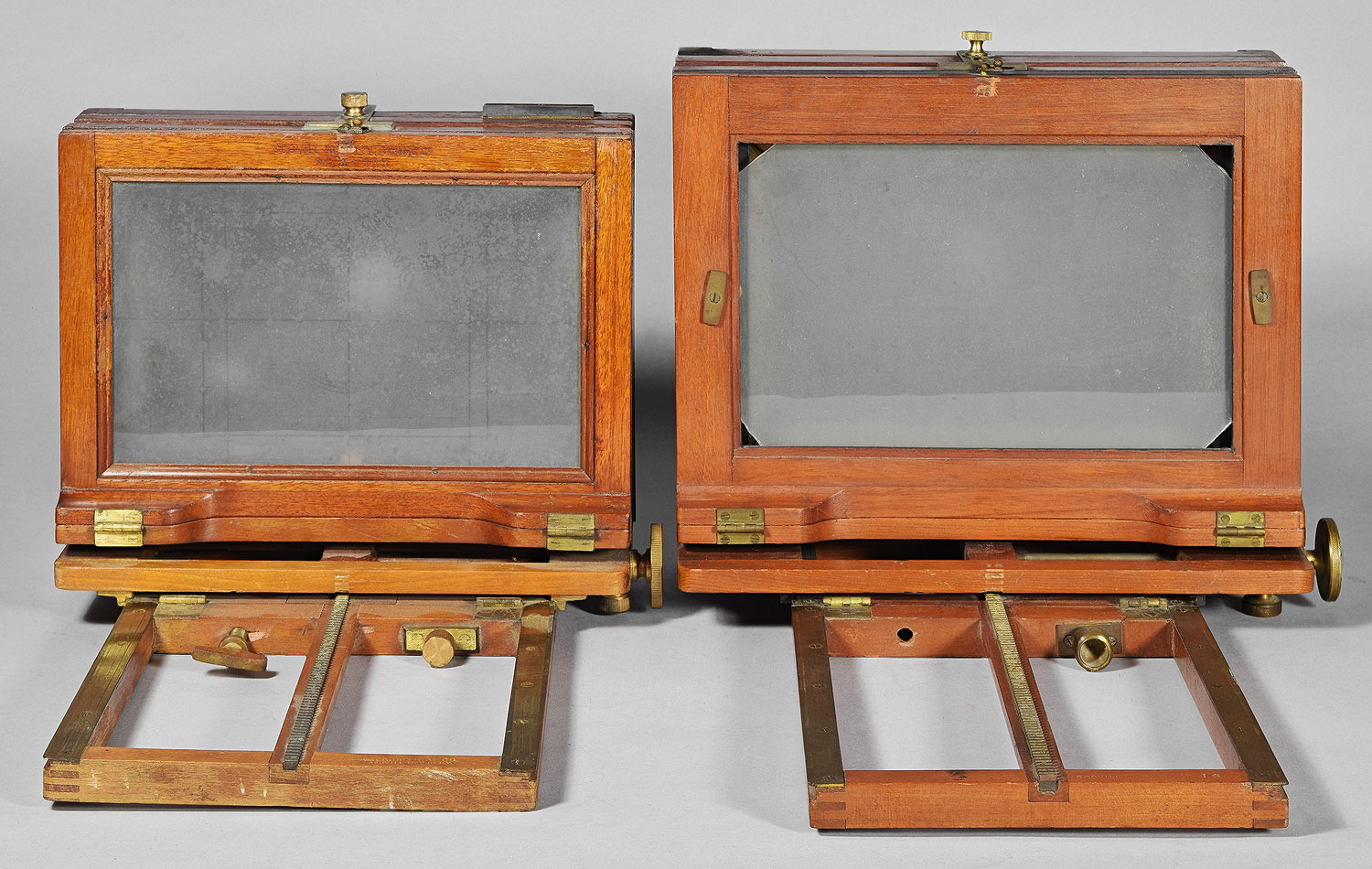
Photographic Times 5, July 1875, pp. 168-169 (introduced
as a Pocket Camera)
Photographic Times 6,
March 1876, pp.
65-170 (the
5x8 size as The 76 Pocket Camera, 4x4 and 4x5 sizes as Pocket
Camera)
Photographic Times 8,
May 1878, p. 100 (The 76 Pocket Camera, sizes not mentioned)
American Optical Catalog, 1878, p. 19-20
The Photographer's Friend, 7th ed.,
Richard Walsl (Baltimore, MD) Catalog, 1882,
p. 51 (under the catchall term AO's Dry Plate
Outfits for Amateurs)
Illustrated Catalogue of General Photographic
Supplies,
Thos. H. McCollin (Philadelphia,
PA), 1882, p. 15
Un-named Four Page Flyer of Cameras & Supplies, Scovill Mfg. Co. (New
York, NY), c.1882, p.2 (as American Optical Company's Apparatus Outfits)
How to Make Photographs and Descriptive Price List,
Scovill Mfg. Co. (New York, NY),
distributed by Wilson, Hood & Co.
(Philadelphia, PA) Catalog, 1883
How to Make Photographs and Descriptive Price List,
Scovill Mfg. Co., distributed by C.H. Codman (Boston, MA),
1883, p. 13 (as AO's Apparatus Outfits)
How to Make Photographs and Descriptive Price List,
Scovill Mfg. Co., distributed by Wilson, Hood & Co. (Philadelphia,
PA),
1883, p. 13 (as AO's Apparatus Outfits)
The Photographic Times and American Photographer, Vol. XIV, No. 158,
New Series No. 38, Scovill Mfg. Co., February 1884, ads p. 48 (in an
ad for Wilson, Hood & Co. (not specific, but probably under the catchall
term Dry Plate Outfits).
Scovill's Photo. Series No. 1, The Photographic
Amateur, 2nd Edition, J. Traill Taylor,
Scovill Mfg. Co. pub. (New York, NY), 1883,
2nd Ed. about 1885, p. a11 (as AO's
Apparatus Outfits)
Scovill's Photo. Series No. 17 - First Lessons in Amateur Photography,
Randall Spaulding, Scovill Mfg. Co. pub. (New York, NY), copyright 1886,
p.a11
How to Make Photographs and Descriptive Price List,
Scovill Mfg. Co. (New York, NY), distributed by
Andrew J. Smith (Providence, RI),
1886, p. 35 (as AO's
Apparatus Outfits)
Scovill's Photo. Series No. 12,
Photographic Chemistry, Scovill Mfg. Co.
(New York, NY), 1886, p. a19 (as AO's
Apparatus Outfits)
Scovill's Photo. Series No. 20, Dry
Plate Making for Amateurs, Scovill Mfg. Co. (New
York, NY), 1886, p. a11 (as AO's Apparatus
Outfits) and a27 (large engraving)
Catalog P, Photographic Material,
J. W.
Queen & Co. (Philadelphia, PA), 1886, p. 60 (Queen
designations P-340 through P-344)
Scovill's Photo. Series No. 20, Dry
Plate Making for Amateurs, Scovill Mfg. Co. (New
York, NY), 1886, p. a11
(as AO's Apparatus Outfits)
and p. a24 (in
Instantaneous Outfits)
How to Make Pictures, 4th edition, Henry Clay Price, Scovill Mfg.
Co., publishers (New York, NY), dated 1887, copyright 1886, p.a10 (as
Centennial Outfits)
How to Make Photographs and Descriptive Price List,
Scovill Mfg. Co. (New York, NY), distributed by
C.H. Codman & Co. (Boston, MA), April 1887, p.
a34 (as Centennial Outfits)
Scovill Manf'g Co. Catalogue Photographic Goods, June, 1887, David
Tucker & Co. (Buffalo, NY), June, 1887, p.178
How to Make Photographs and Descriptive Price List,
Scovill Mfg. Co. (New York, NY),
undated but about January 1888, p. 33
An
Illustrated Catalogue of Photographic Cameras, Lenses and Other
Apparatus and Materials for Photography, W.H. Walmsley & Co.
(Philadelphia, PA), April 1, 1888, p. 15
How to
Make Photographs and Descriptive Price List, Scovill Mfg. Co. (New
York, NY), May 1888, p. 22 (as Centennial Outfits) - large engraving on
p. 114)
How to Make Photographs and Descriptive Price List,
Scovill Mfg. Co., distributed by John Wanamaker
(Philadelphia, PA), June 1888,
p. 22 (as Centennial Outfits)
How to Make Photographs and Descriptive Price List,
Scovill Mfg. Co. (New York, NY), distributed by
C.H. Codman & Co. (Boston, MA),
September
1888, p.
22 (as Centennial Outfits)
How to
Make Photographs and Descriptive Price List, Scovill Mfg. Co. (New
York, NY), November 1888, p. 22 (as Centennial Outfits)
How to Make Photographs and Descriptive Price List,
Scovill Mfg. Co. (New York, NY), distributed by
Buchanan, Bromley
& Co. (Philadelphia, PA), 1888
How to Make Photographs and Descriptive Price List,
The Scovill & Adams Co.
(New York, NY), January 1889, p. 21 (as
Centennial Outfits)
How to Make Photographs and Descriptive Price List,
The Scovill & Adams Co. (New York, NY), distributed by
Buchanan,
Bromley & Co. (Philadelphia, PA) Catalog, 1889
How to Make
Photographs and Descriptive Price List, The Scovill & Adams Co.
(New York, NY, 1890, p.23
How to Make Photographs and Descriptive Price List,
The Scovill & Adams
Co. (New York, NY), distributed by Oscar Foss (San Francisco, CA), June
1890, p. 23 (as Centennial Outfits)
How to Make Photographs and Descriptive Price List,
The Scovill & Adams
Co. (New York, NY), January
1891, p. 23 (as Centennial Outfits)
How to Make Photographs and Descriptive Price List,
The Scovill & Adams
Co. (New York, NY), distributed by Sargent & Co. (Cleveland, OH), April
1891, p. 11
How to Make Photographs and Descriptive Price List,
The Scovill & Adams
Co. (New York, NY), distributed by Horgan, Robey & Co. (Boston, MA),
June 1891, p. 13 (as Centennial Outfits)
How to Make Photographs and Descriptive Price List,
The Scovill & Adams Co. (New York, NY),
January 1892, p. 13 (as Centennial Outfits)
How to Make Photographs and Descriptive Price List,
The Scovill & Adams
Co. (New York, NY), abt. June 1892, p. 13 (as Centennial
Outfits)
How to Make Photographs and a Descriptive
Catalogue of Photographic Materials Illustrated,
The Scovill & Adams Co.
(New York, NY), 1896, p.
32 (as Centennial Outfits)
